Every trek is an opportunity to introspect, reassess priorities, simplify life and grow as a person. This year our group of 8 women decided to take a week’s break from the real world to go to Ladakh and do the Indus Valley Trek.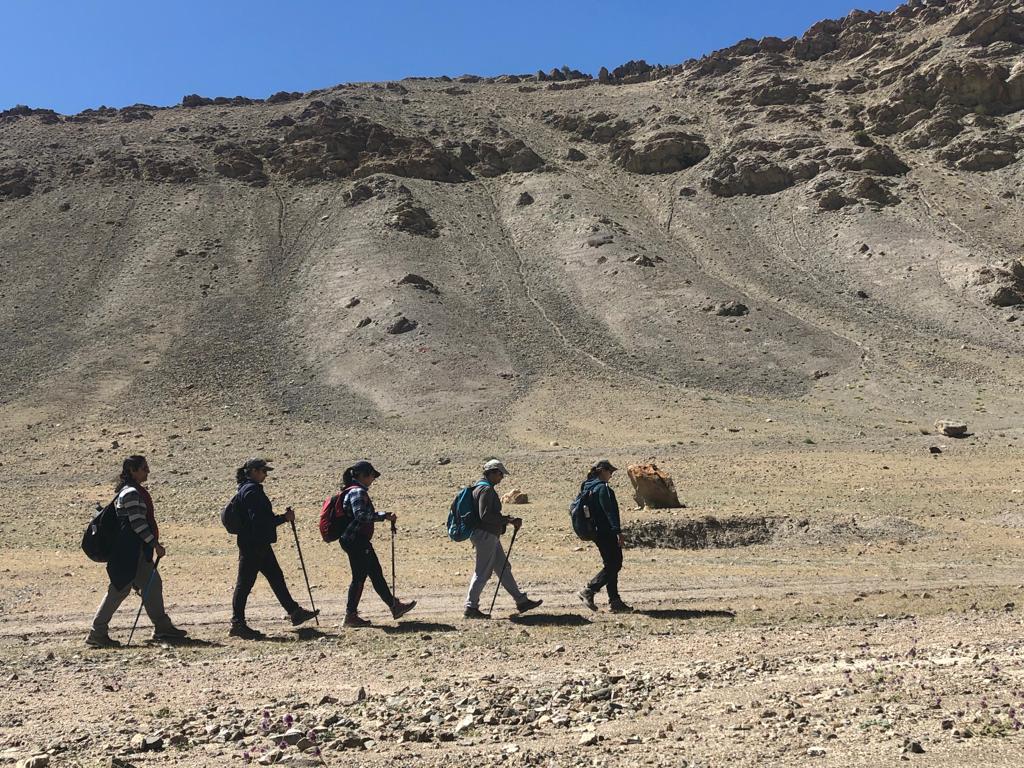 This time we also chose not to pitch tents but to stay with local families and experience the life and culture of rural Ladakh.
This time we also chose not to pitch tents but to stay with local families and experience the life and culture of rural Ladakh.
Our adventure began much before reached Ladakh.
We booked our tickets and within a week the Government of India revoked Article 370. Ladakh became India’s newest Union Territory. While our tour organiser told us that Ladakh was in a celebratory mood, we were concerned and did not want to say or do anything that could jinx our trek.
We started from Bangalore on the night of 4th September.  We flew to New Delhi and from there to Leh.
We flew to New Delhi and from there to Leh.
We had what we thought was a safe gap of 3.5 hours between the two flights. But Murphy’s Law was in action! Our flight took off over 30 minutes late. Once we landed, we had to wait for almost 20 minutes to get off the flight. We then endured what we felt was the longest bus ride from the flight to the airport. And yes! Our bags were the last to come.
Moreover, we had to crossover to another terminal about 300 metres away. We reached the terminal with just about an hour for our flight to take off.We requested other passengers, cut through queues and managed to check in. There was a huge queue for the security and once again we had to request other travellers to allow us to go first. 5 of us completed our security check and started walking towards the departure gate. We were tempted to stop for coffee but were warned by an airport staff that our gate was a long walk.Thankfully we did not stop. It was an unexpectedly long walk and we got there just before the bus was scheduled to leave. We requested them to wait for our 3 friends. The rather irritated airline staff said they would not wait for more than 5 minutes. It was a tense 5 minutes as our friends were not responding to our calls. Finally we saw them running towards the gate, shoes in one hand, jacket in another, hair falling loose.. .they were a sight! But they made it and we had a good laugh over the experience.
The adventure and the fun had begun!
The flight to Leh was beautiful. 
 Exactly a month after Ladakh got Union Territory status, we landed there.
Exactly a month after Ladakh got Union Territory status, we landed there.
No words or picture can truly capture the surreal beauty of the world highest desert region.  Leh is at an altitude of 3500 metres and it is common to feel the impact of altitude sickness if one flies in there. All of us felt that our breathing was laboured and we were extremely conscious of our breath. We were surprised to find oxygen cylinders for sale at the airport. 2 of our group members picked up these cylinders ‘just to be safe’.
Leh is at an altitude of 3500 metres and it is common to feel the impact of altitude sickness if one flies in there. All of us felt that our breathing was laboured and we were extremely conscious of our breath. We were surprised to find oxygen cylinders for sale at the airport. 2 of our group members picked up these cylinders ‘just to be safe’.
We were greeted by our tour guide Urgyan and driven Stenzin who were to stay with us for our entire trip.
The airport was just a 10 minute drive from our homestay. Post tea and breakfast, we were asked to relax and get some sleep. We were also told to drink plenty of water and stay hydrated all the time. We were also asked not to have a bath that day. The first 2 days were meant for acclamatization and in our case it was extremely important as we had to start trekking from day 3.
Leh town was pretty. Most homes and hotels had a similar façade. They were all set on large plots of land. 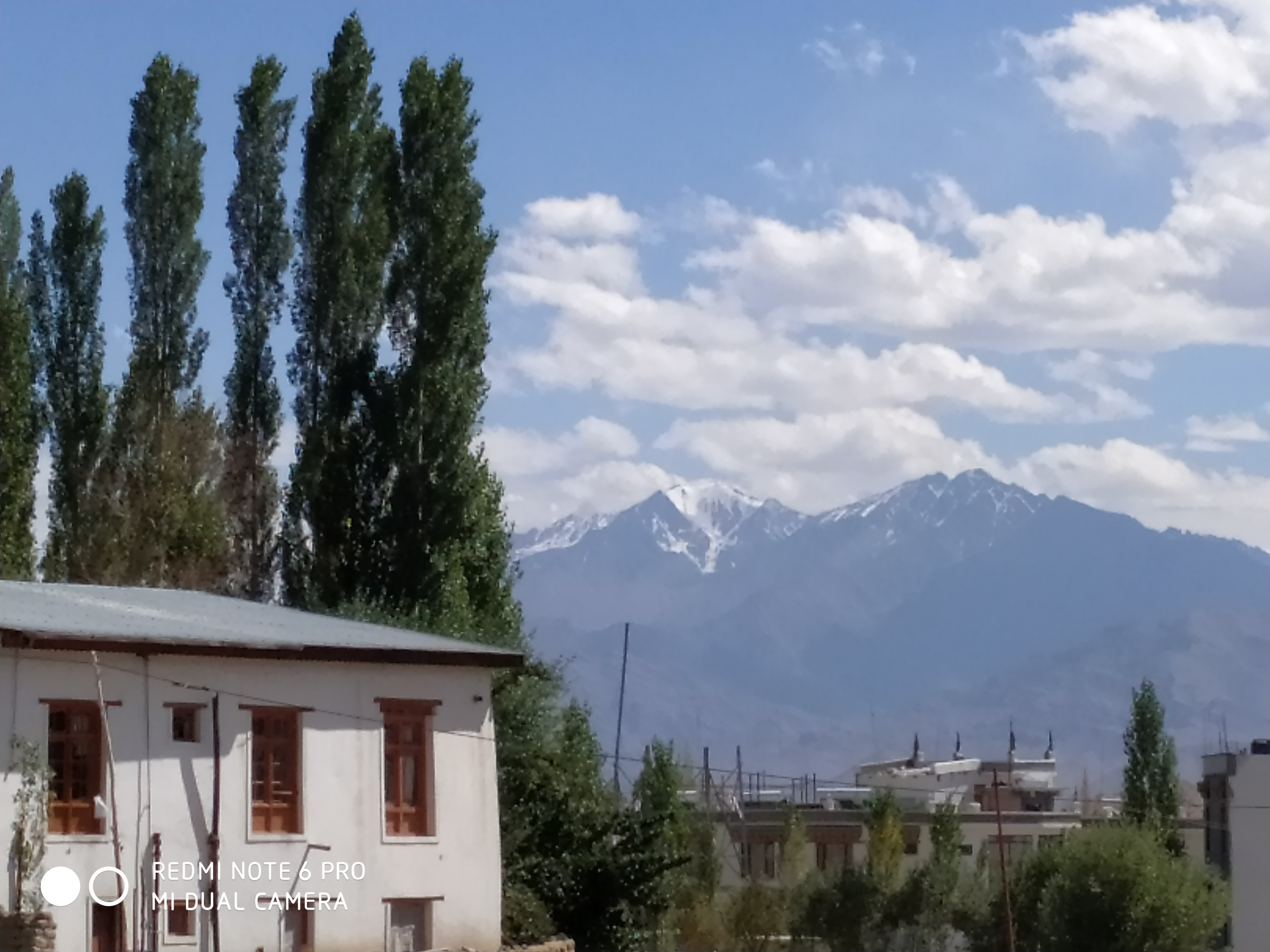
 After 2-3 hours of rest, we set out to the Leh market for lunch. Some of us went to the ‘Tibetan Kitchen’ for traditional food while others went to the famous German Bakery.
After 2-3 hours of rest, we set out to the Leh market for lunch. Some of us went to the ‘Tibetan Kitchen’ for traditional food while others went to the famous German Bakery.
Post lunch we explored the Leh market.  It was amazing too see the range of Tibetan handicrafts and jewellery.
It was amazing too see the range of Tibetan handicrafts and jewellery. 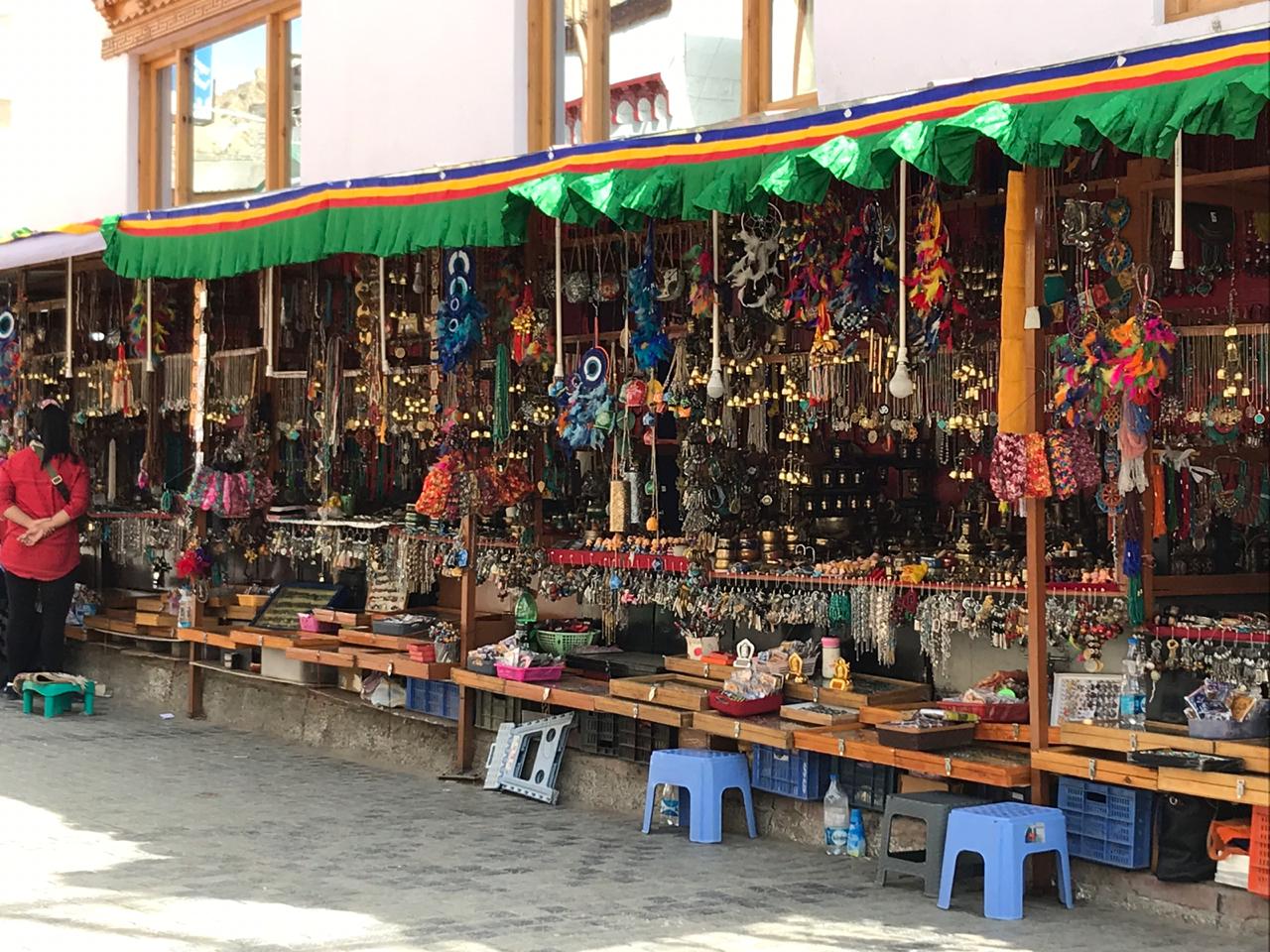 We were particularly fascinated by the roadside shops selling dry fruits and Yak Cheese.
We were particularly fascinated by the roadside shops selling dry fruits and Yak Cheese.  We then saw a fruit seller offering fresh apricots.
We then saw a fruit seller offering fresh apricots.  The fruit was delicious and over the next week I ate ridiculous amounts of the fresh fruit.
The fruit was delicious and over the next week I ate ridiculous amounts of the fresh fruit.
That evening we went to the ‘Hall of Fame’ and the war Memorial.  The Hall of Fame is a beautifully curated museum that showcases the social, cultural and military history of the Ladakh region. There is a huge military presence in the Ladakh region and the war memorial is a tribute to our soldiers as well as poignant reminder of the 1700+ soldiers who have been martyred here.
The Hall of Fame is a beautifully curated museum that showcases the social, cultural and military history of the Ladakh region. There is a huge military presence in the Ladakh region and the war memorial is a tribute to our soldiers as well as poignant reminder of the 1700+ soldiers who have been martyred here.  We also saw a sound and light show focussing on key battles of the Kargil war. Most members of our group had closely followed the war 20 years ago and we were in tears as we learnt details about the valiant struggles of our soldiers. After the show, some of our group members walked up to our soldiers and thanked them for their selfless service. They were gracious and told us, “ hamara to kaam hai! “( it is our work).
We also saw a sound and light show focussing on key battles of the Kargil war. Most members of our group had closely followed the war 20 years ago and we were in tears as we learnt details about the valiant struggles of our soldiers. After the show, some of our group members walked up to our soldiers and thanked them for their selfless service. They were gracious and told us, “ hamara to kaam hai! “( it is our work).
The next day we visited the Hemis and Thiskey monasteries. On the way we got the first glimpse of the Indus ( known in Sanskrit as Sindhu) river.  This river finds a mention in the Rig Veda. Personally it was a strangely moving to see the river that gave both my country and my faith their name. Persians referred to us as ‘Hindus’ or people of the land who lived beyond the Sindhu river.
This river finds a mention in the Rig Veda. Personally it was a strangely moving to see the river that gave both my country and my faith their name. Persians referred to us as ‘Hindus’ or people of the land who lived beyond the Sindhu river.
After spending some time at the river, we went to the Hemis monastery, the regions richest monastery.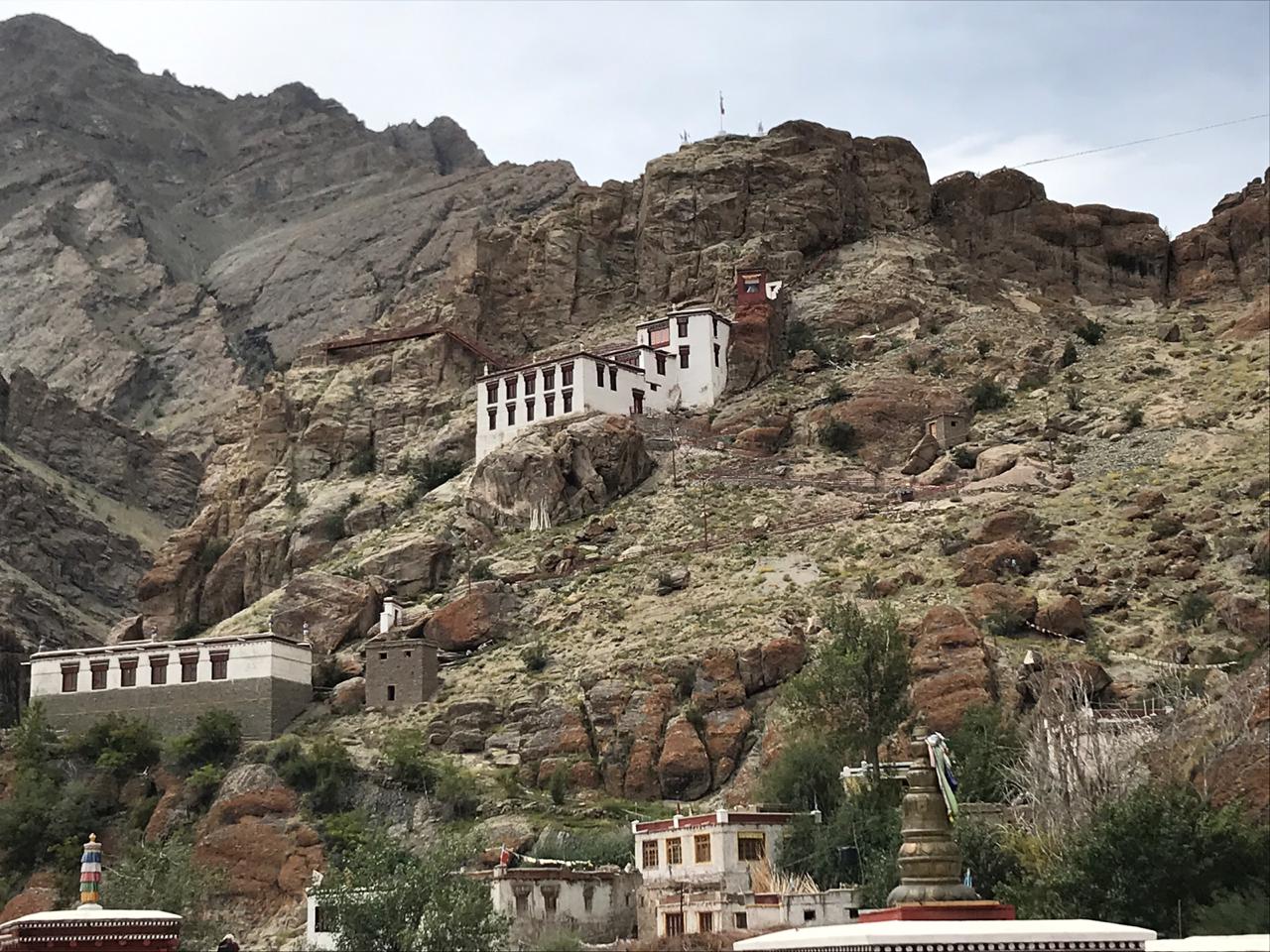 Our guide told us that this monastery was untouched by invading armies as it was hidden between mountains. The monastery which is close to a 1000 years old was serene and beautiful. We were also surprised to find large wooden pillar and carvings similar
Our guide told us that this monastery was untouched by invading armies as it was hidden between mountains. The monastery which is close to a 1000 years old was serene and beautiful. We were also surprised to find large wooden pillar and carvings similar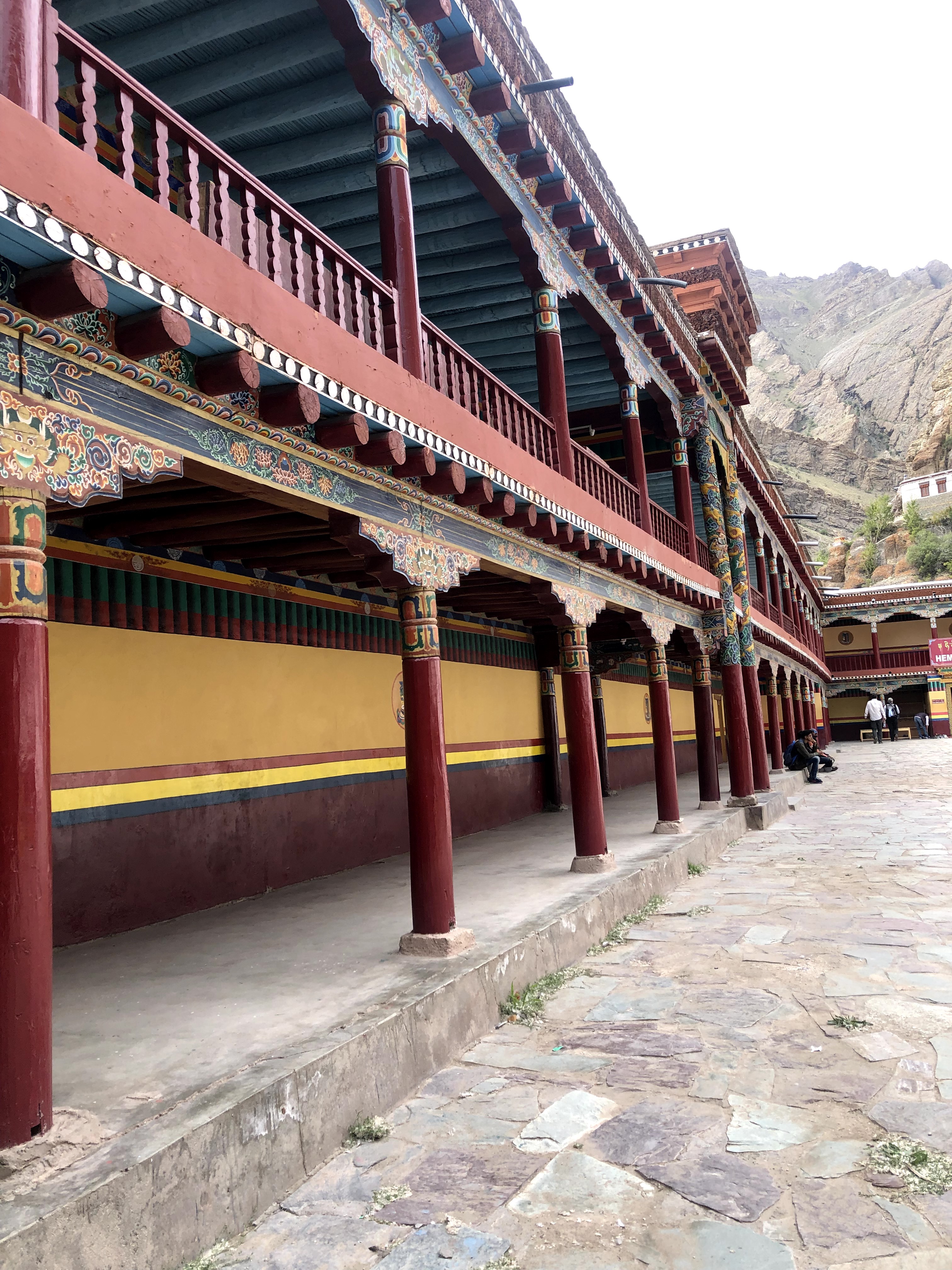 to those found in southern India in the monastery.
to those found in southern India in the monastery.
Thiskey monastery with beautiful Maitreya Buddha  was also lovely and offered breathtaking views of the Ladakhi landscape.
was also lovely and offered breathtaking views of the Ladakhi landscape. 
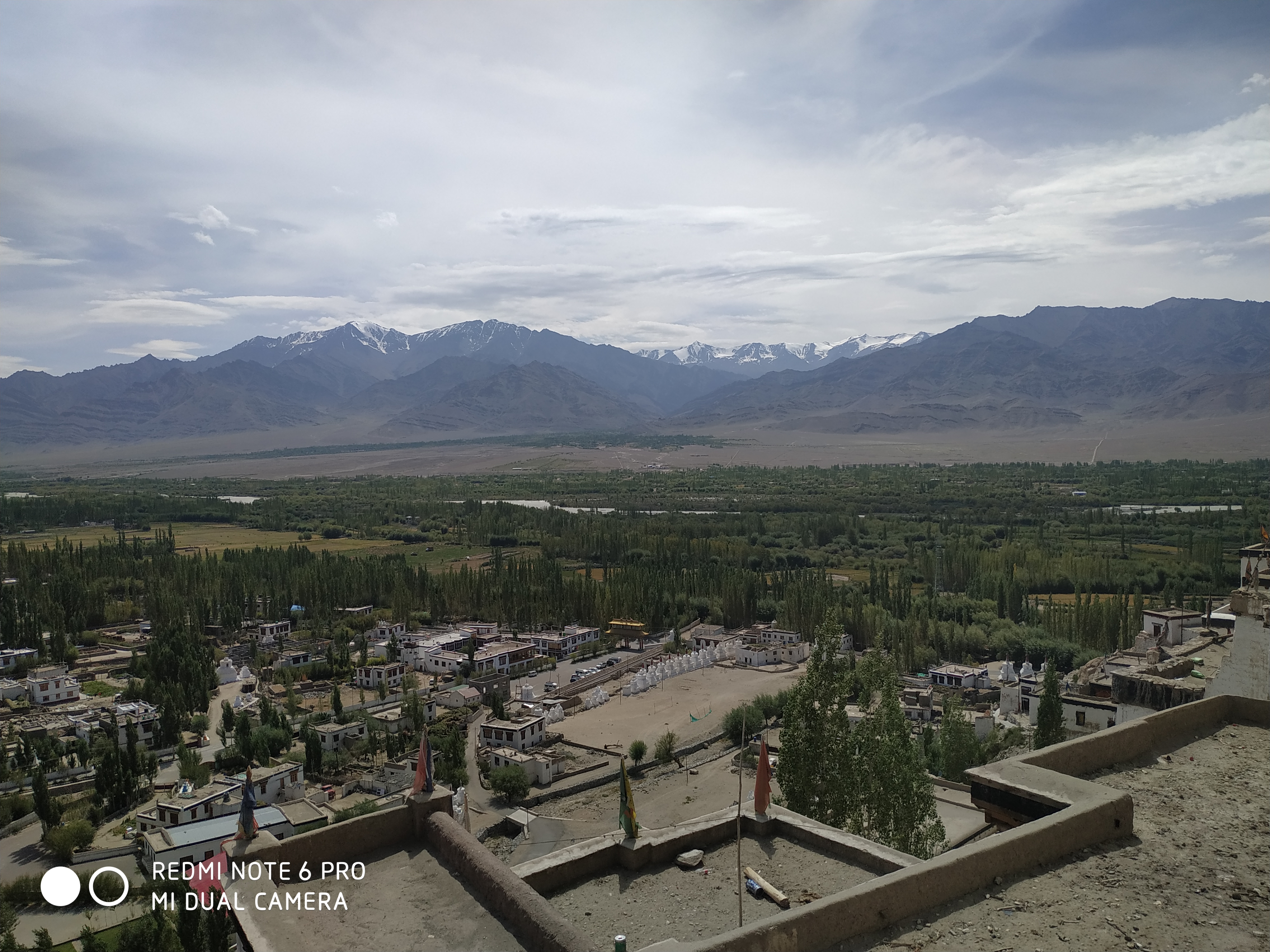 We also saw some monks preparing the ‘Mandala’, an elaborate pattern using various natural colours.
We also saw some monks preparing the ‘Mandala’, an elaborate pattern using various natural colours.  Our guide told us that the ‘Mandala’ depicted the impermanence of life. The monks could take upto 2 weeks to complete the Mandala but it would be washed away on the completion of a particular prayer ritual. Similarly human beings are always expected to do our best. But even our best creations are washed away with time.
Our guide told us that the ‘Mandala’ depicted the impermanence of life. The monks could take upto 2 weeks to complete the Mandala but it would be washed away on the completion of a particular prayer ritual. Similarly human beings are always expected to do our best. But even our best creations are washed away with time.
Our next visit was to Khardungla Pass. We were thrilled to be going to the world’s highest motorable road. The Ladakh Ultramarathon was held that morning and we saw several runners along the way. We also spotted a herd of Yak grazing along the way.
We were thrilled to be going to the world’s highest motorable road. The Ladakh Ultramarathon was held that morning and we saw several runners along the way. We also spotted a herd of Yak grazing along the way.  Finally we got to Khardungla Pass. Again the instructions given were: No talking unnecessarily, no walking fast and not more than 20 minutes at the top. It was freezing there. We posed for the customary photos and walked around a bit.
Finally we got to Khardungla Pass. Again the instructions given were: No talking unnecessarily, no walking fast and not more than 20 minutes at the top. It was freezing there. We posed for the customary photos and walked around a bit.  Khardungla was a rather disorienting experience. Almost al of us felt light headed. There were moments of absolute clarity interspersed with moment of total disorientation.
Khardungla was a rather disorienting experience. Almost al of us felt light headed. There were moments of absolute clarity interspersed with moment of total disorientation.
Post Khardungla, we felt there was plenty of oxygen in the air in Leh. I suppose we were now acclamatized!
That evening we met our trek guide Sonam. He told us that day 3 of the trek was the most challenging one. He said he would see how we all do on day 1 and then let us know whether we would be able to do day 3.
As we were staying in villages we had a support vehicle to carry our luggage. Also we were told that there were points where the trek route met the road. So if any of us was tired, we could opt to take the vehicle.We were all excited and looked forward to starting the trek the next morning.
The next morning, post breakfast we drove to Likir, the starting point of our trek. It was a pleasant 2 hour drive.
The roads in Ladakh were surprisingly good and travel from one place to another was not difficult despite the terrain.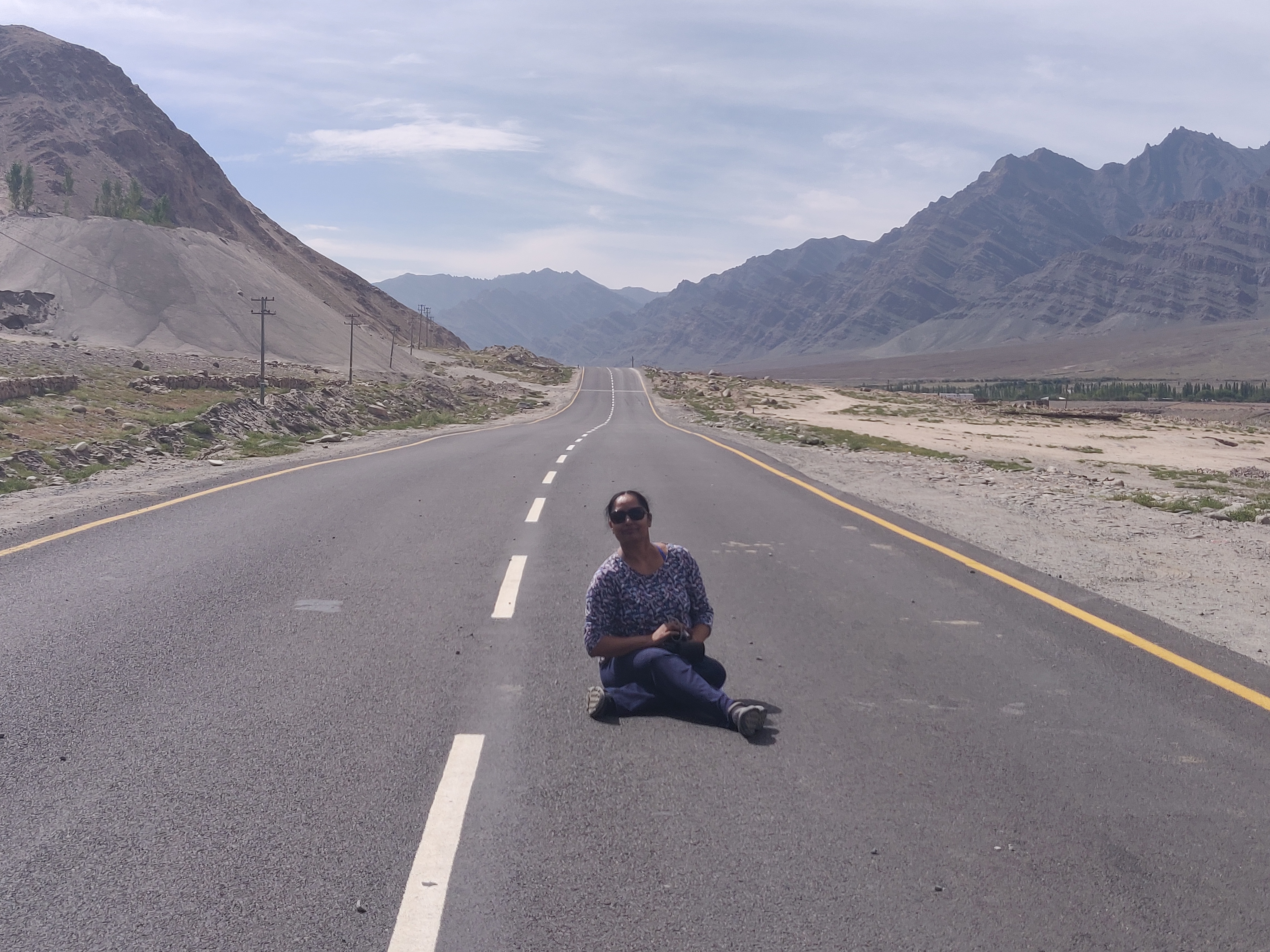 Urgyan, our guide is also a musician. He carried his guitar and kept us entertained during these drives. For the trek Sonam was our main guide. Urgyan also trekked with us but it was his first trek as well.
Urgyan, our guide is also a musician. He carried his guitar and kept us entertained during these drives. For the trek Sonam was our main guide. Urgyan also trekked with us but it was his first trek as well.
At about 10.30 we started the trek from Likir. 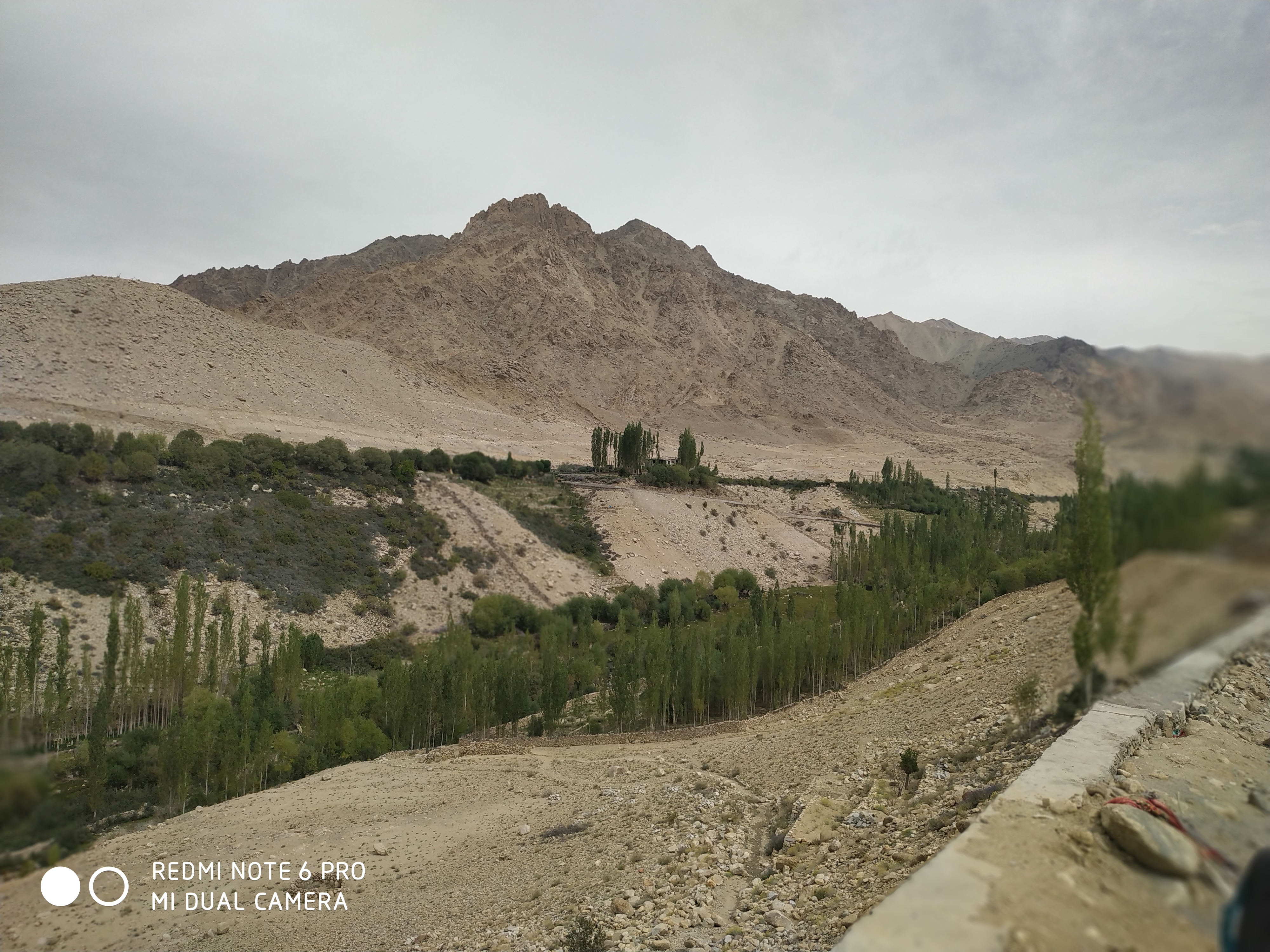
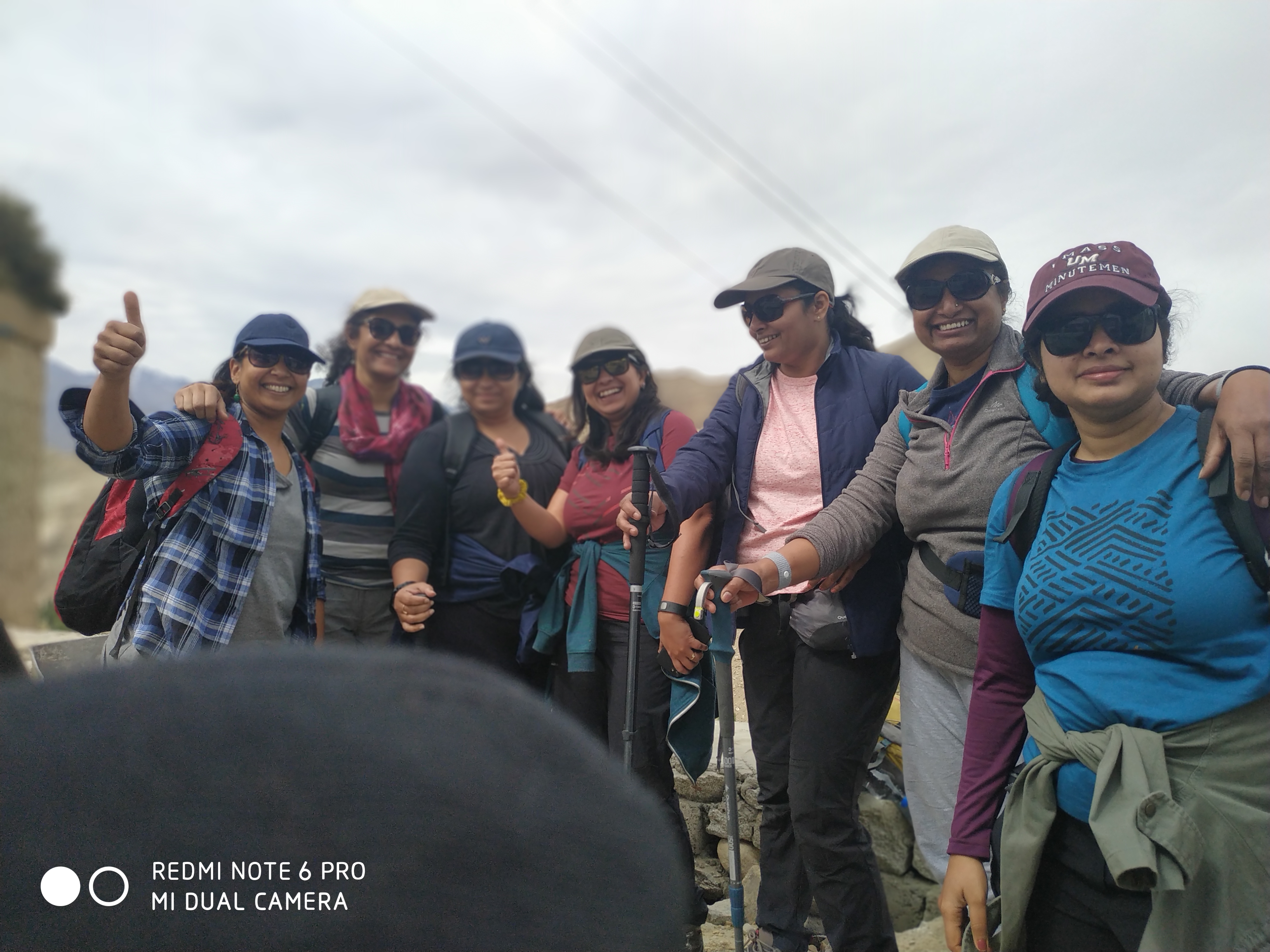 The next 4 days would be spent in remote areas of rural Ladakh amidst apricot farms and gurgling steams. It was also unlikely that we would have mobile connectivity for this period.
The next 4 days would be spent in remote areas of rural Ladakh amidst apricot farms and gurgling steams. It was also unlikely that we would have mobile connectivity for this period.
As we started our trek, we came across the first cluster or ‘mane’ or prayer stones, a common sight in the region. Our guides told us that it was a local custom to walk around these in clockwise direction. This was something we religiously followed for the rest of the trek.
Our guides told us that it was a local custom to walk around these in clockwise direction. This was something we religiously followed for the rest of the trek.
After about 2 hours of trekking we crossed the first pass of our trek Pheobe La at an altitude of about 3600 metres. It was a long walk to dry desolate and dusty mountains.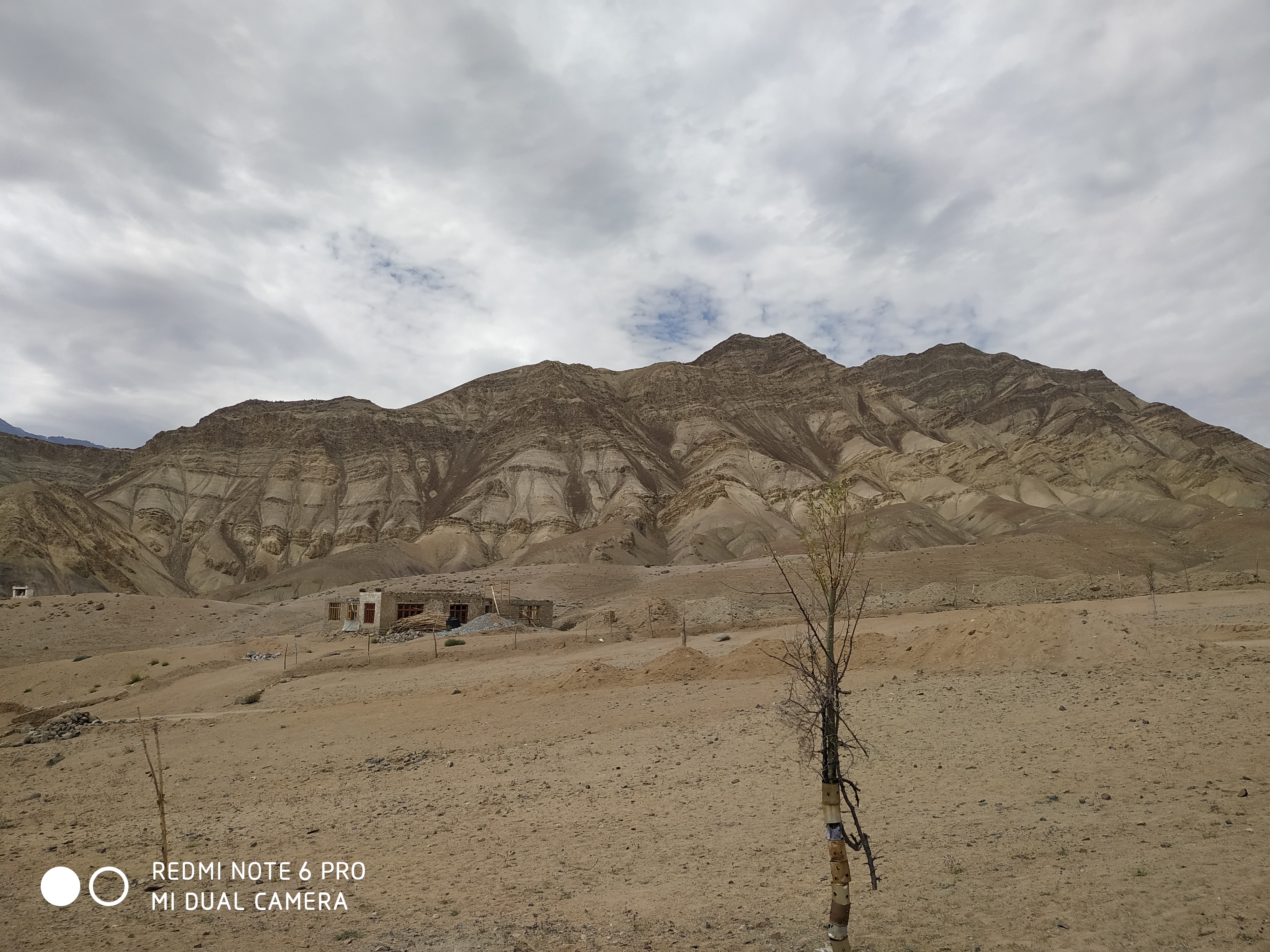
 Looking at the terrain our respect for the army grew even more. “ How did they even manage to feel fight in this terrain? ” we wondered.
Looking at the terrain our respect for the army grew even more. “ How did they even manage to feel fight in this terrain? ” we wondered.
We stopped for lunch by a beautiful stream.  The landscape had changed and it was suddenly lush green. After an interesting lunch of plain chappatis and boiled potato with salt, we headed towards the Charatse La pass
The landscape had changed and it was suddenly lush green. After an interesting lunch of plain chappatis and boiled potato with salt, we headed towards the Charatse La pass at about 3500 metres. Once again the trail was dry and dusty. At some places we even felt that the place looked a bit like the rugged Aravalli mountains in Rajasthan.
at about 3500 metres. Once again the trail was dry and dusty. At some places we even felt that the place looked a bit like the rugged Aravalli mountains in Rajasthan.
After Charatese La pass, the trail was downhill towards Yamthang village. Around 4 pm we caught the first glimpse of Yamthang. Yamthang was a typical Ladakh village nestled between the vast mountains.  I realised that villages in Ladakh are similar to oasis in the desert regions. These villages are usually fed by natural springs or glacial rivers. Agriculture was the main occupation of the villagers.
I realised that villages in Ladakh are similar to oasis in the desert regions. These villages are usually fed by natural springs or glacial rivers. Agriculture was the main occupation of the villagers.
The village home in Yamthang was simple but pretty.  We were amazed to see crockery and chinaware beautiful stacked in the home.
We were amazed to see crockery and chinaware beautiful stacked in the home. 8 of us shared a room with the most amazing view of the mountains.
8 of us shared a room with the most amazing view of the mountains.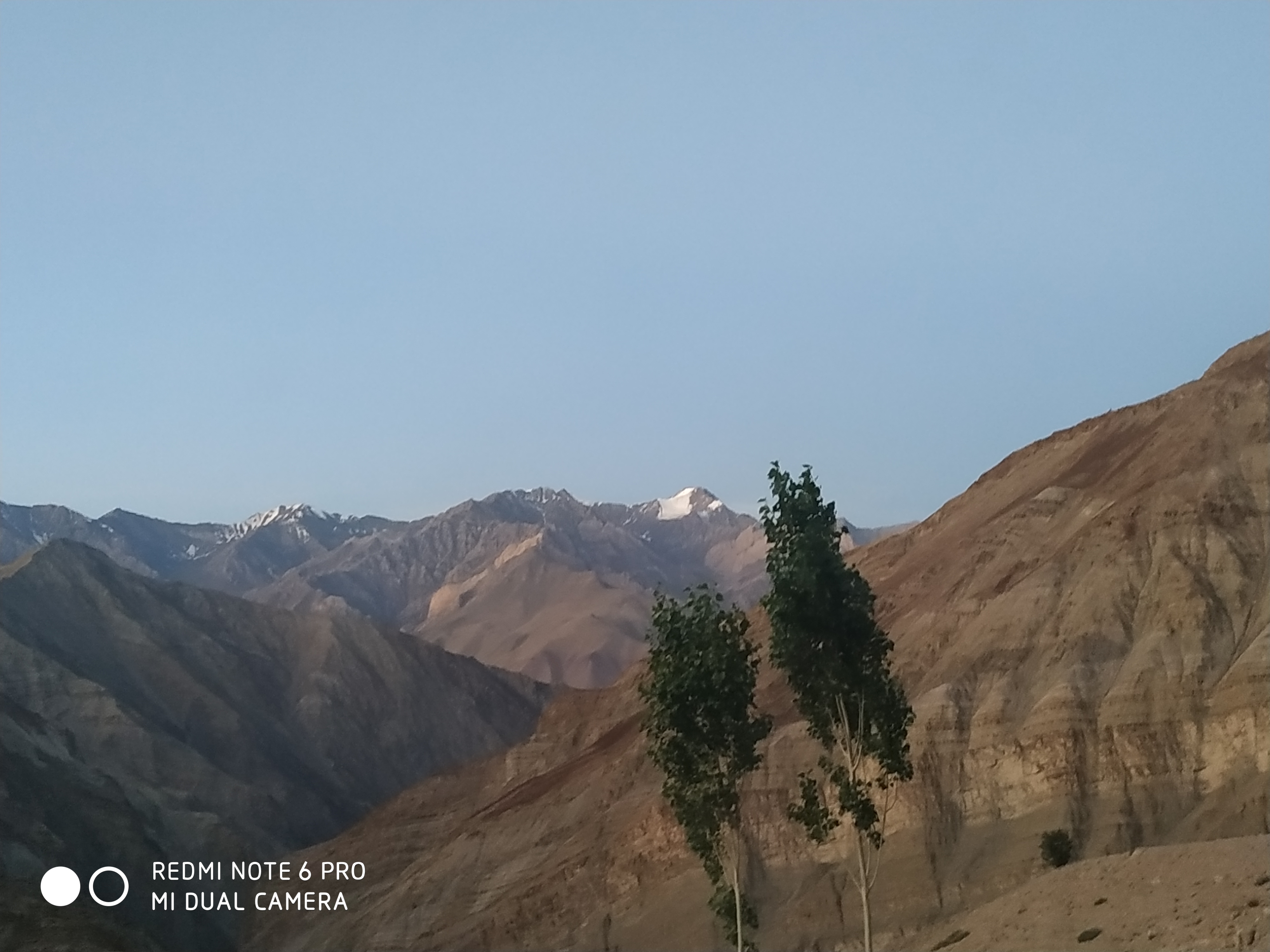 That night we enjoyed a traditional Ladakh meal with Ting mo, a kind of steamed roti.
That night we enjoyed a traditional Ladakh meal with Ting mo, a kind of steamed roti.  It was a happy evening as our guide told us that we all were trekking very well and had even surpassed his expectations. That day we had walked nearly 15 kms.
It was a happy evening as our guide told us that we all were trekking very well and had even surpassed his expectations. That day we had walked nearly 15 kms.
The next morning we bid farewell to our wonderful hosts and started for Hemis Shupkachen. Today was supposed to be an easy trek.
We walked through the beautiful Yamthang village. 

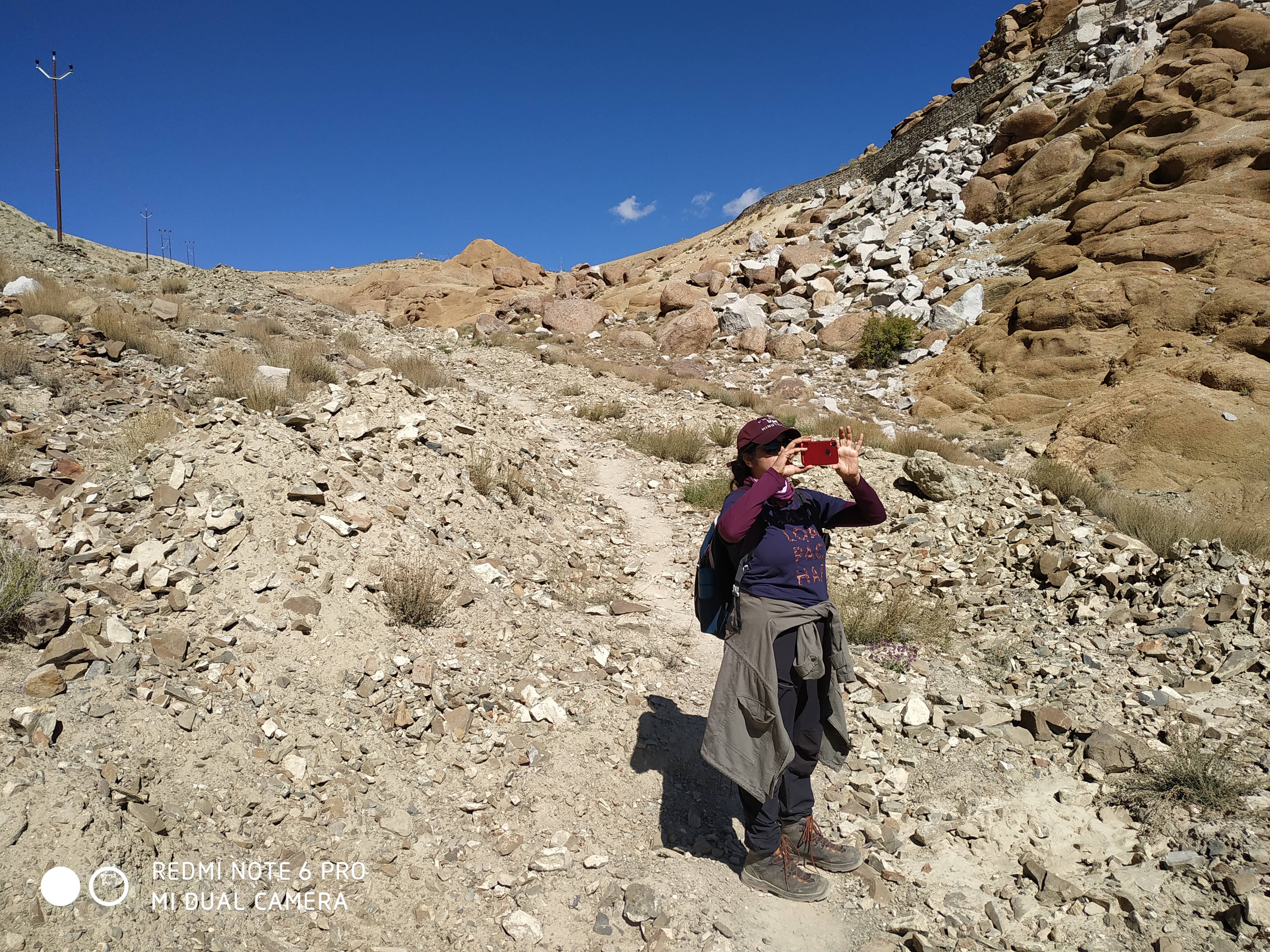 and then the arid mountains. It was a steady uphill walk. We rested several times and had endless sips of water.
and then the arid mountains. It was a steady uphill walk. We rested several times and had endless sips of water.
We also met some biker groups from Indonesia who were extremely happy to see an all Indian, all woman group trekking in Ladakh. 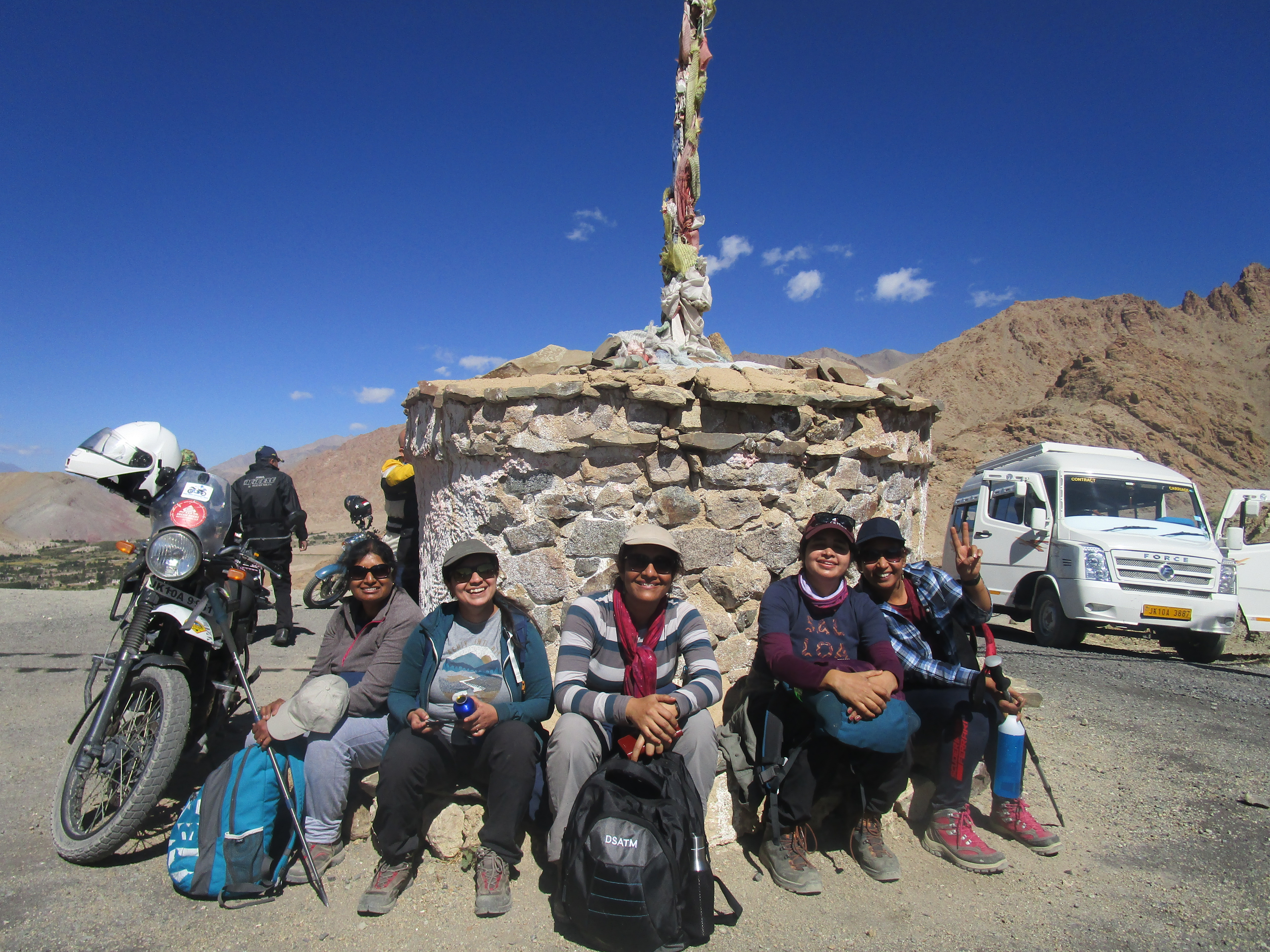
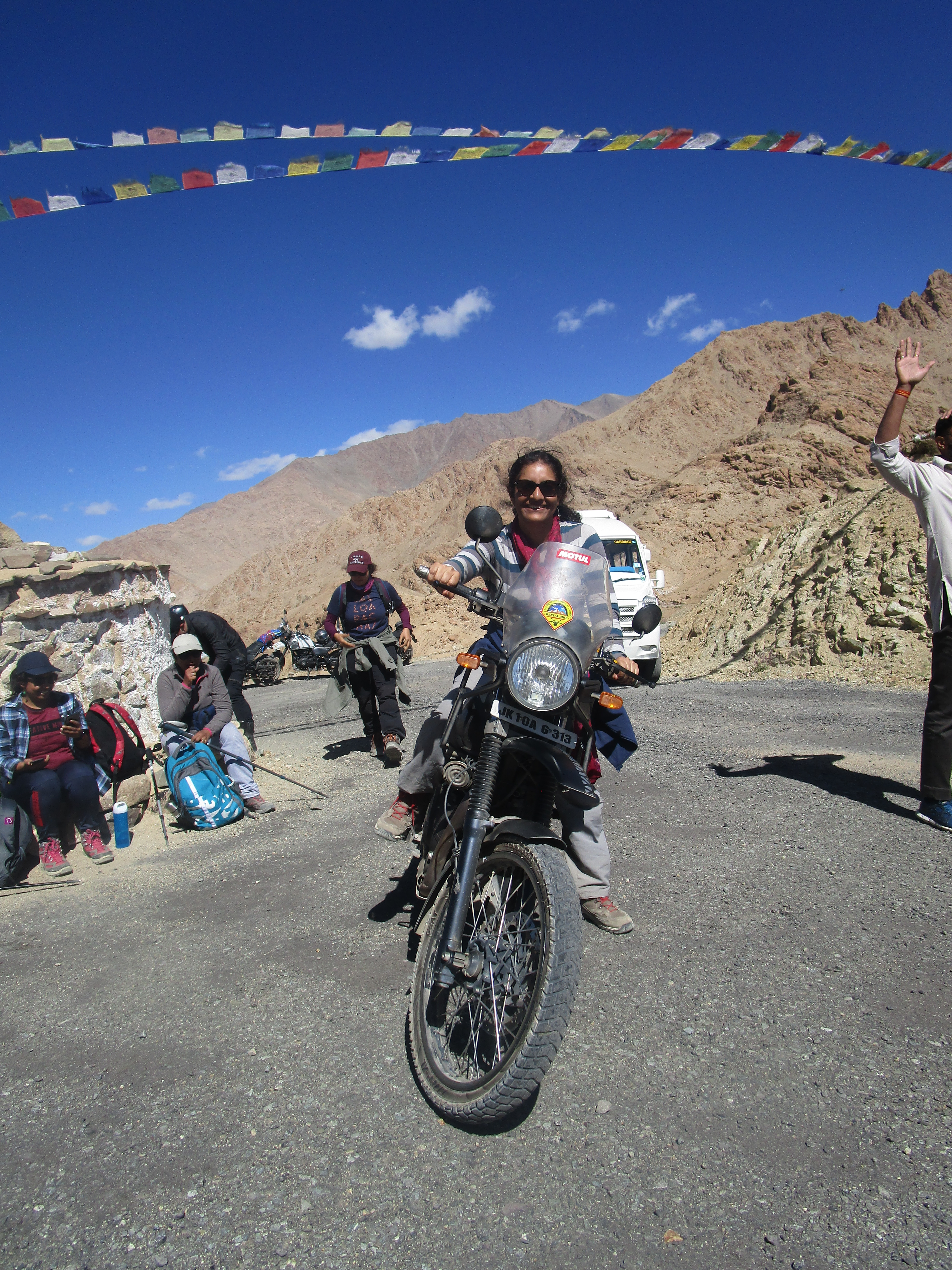 After 5 hours of walking we reached the stunning beautiful village of Hemis Shupkachen. It was my idea of paradise.
After 5 hours of walking we reached the stunning beautiful village of Hemis Shupkachen. It was my idea of paradise.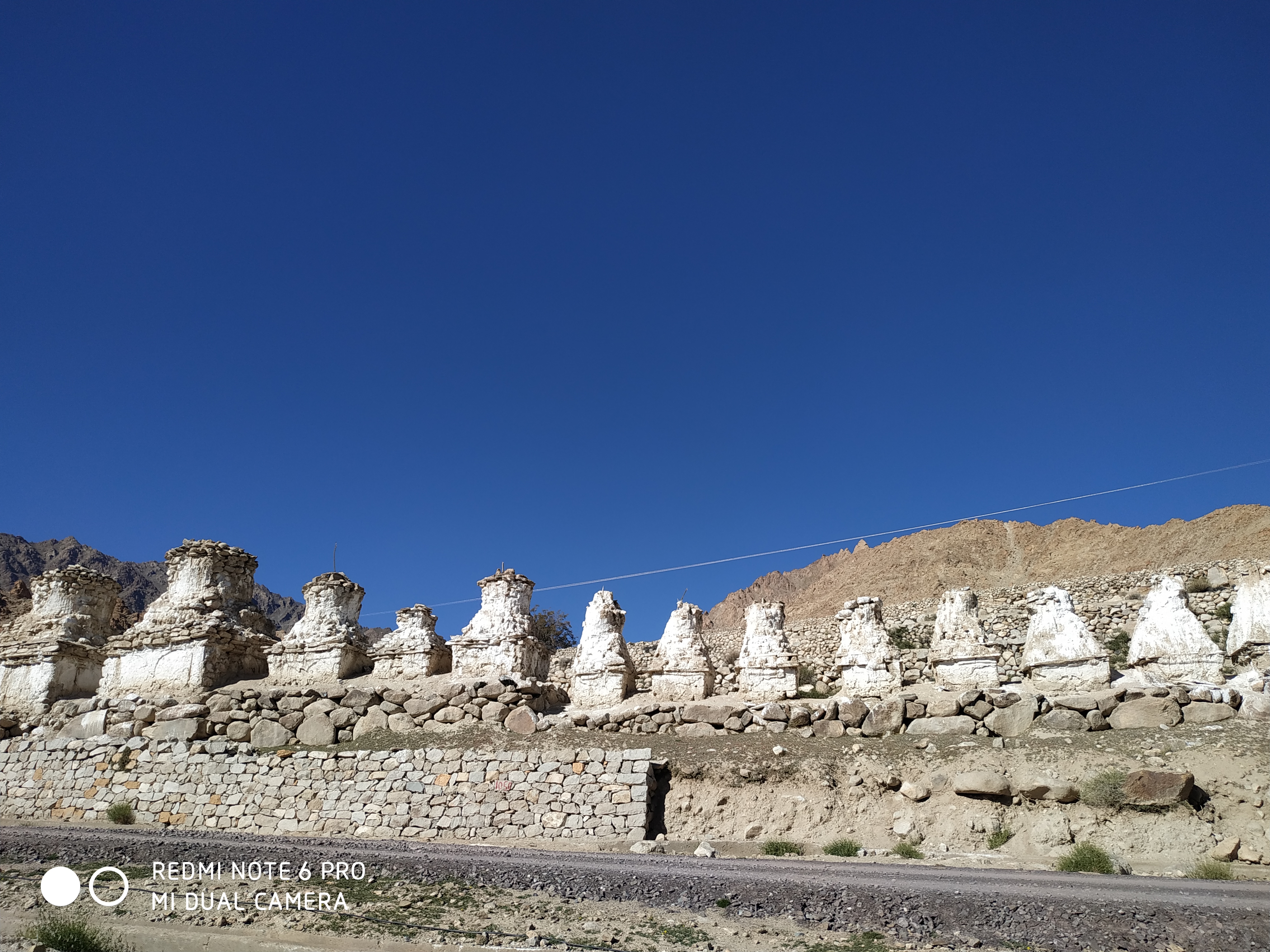
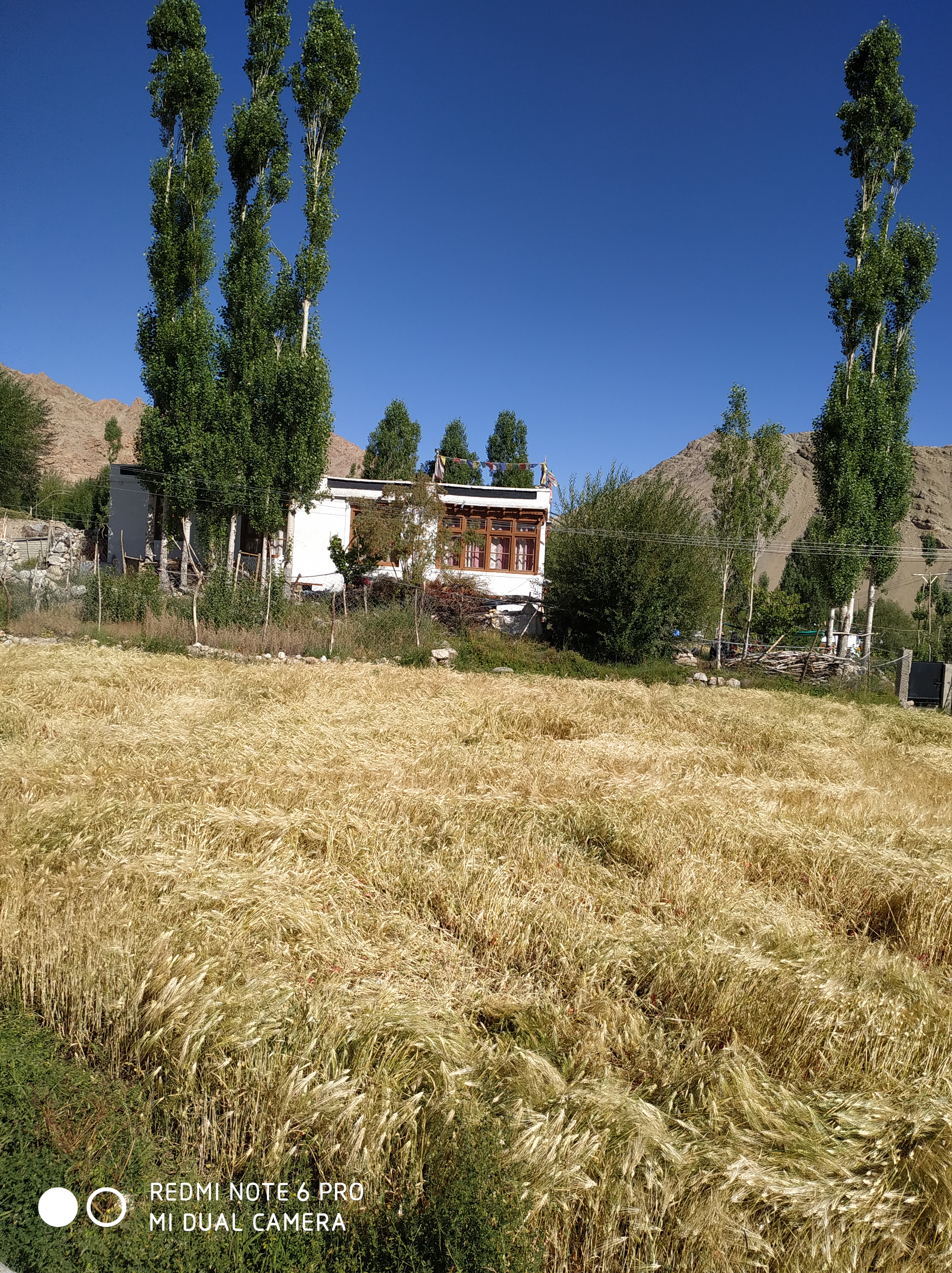

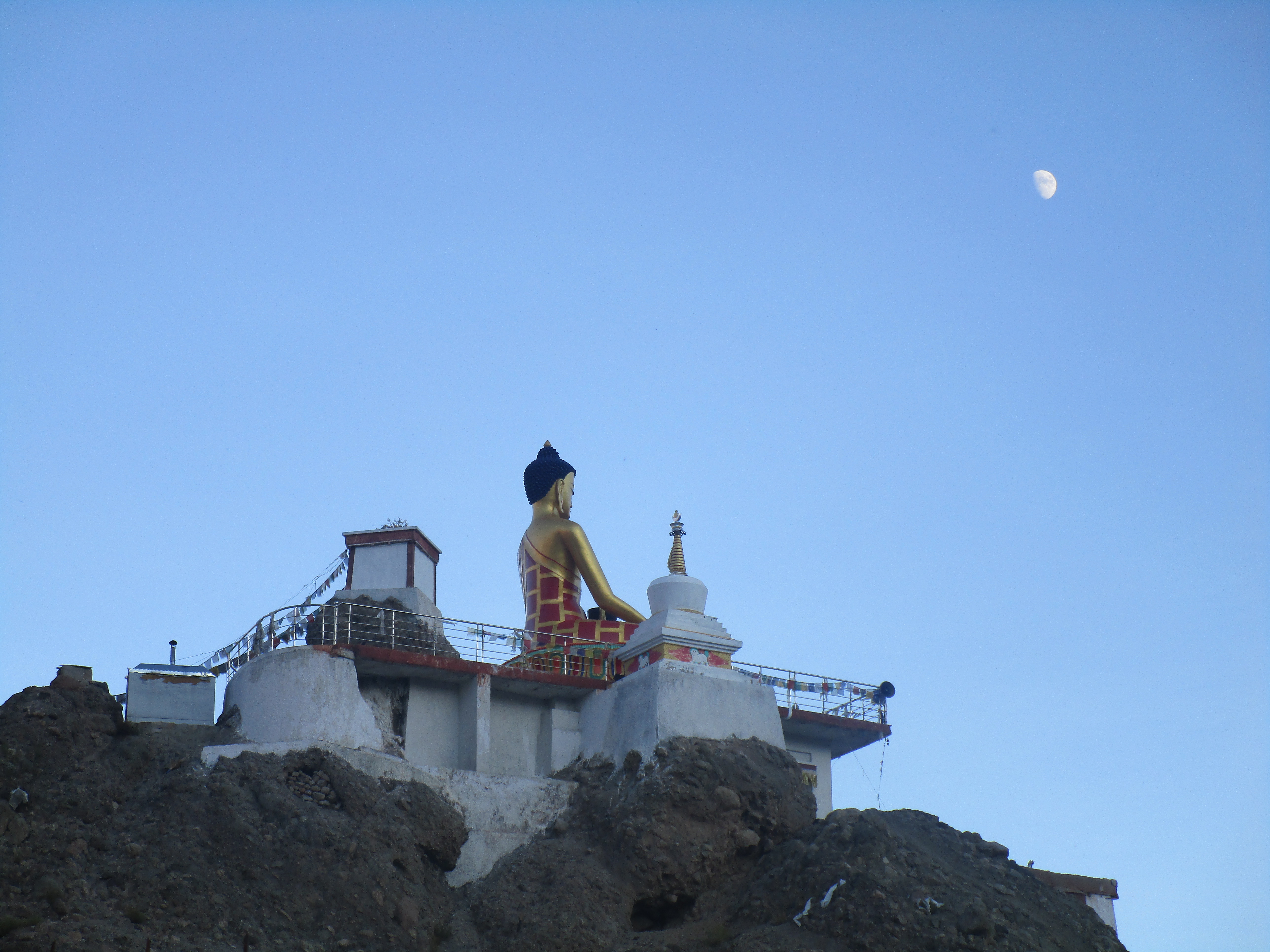 After a quick lunch, 2 of us decided to go and explore the village.
After a quick lunch, 2 of us decided to go and explore the village.
The owner if the homestay told us to take a walk through the lush fields and also go and see the Juniper trees. The leaves of these trees are extremely fragrant. But these were of great significance to the locals and we were asked not to pluck the leaves of the tree.
It was a beautiful walk. We met many locals who guided us.
We passed by these stupas We came across this beautiful meadow where a horse was grazing.  We walked across this to reach the other side of the village. Here we met a young boy working in the fields. We asked him where we could see the Juniper trees. He took us to the trees and even clicked our picture. He then asked us if we had seen the movie “Walking With The Wind”. We had heard about this movie but were unsure. He told us that he was Sonam Wangyal, the protagonist of that movie.
We walked across this to reach the other side of the village. Here we met a young boy working in the fields. We asked him where we could see the Juniper trees. He took us to the trees and even clicked our picture. He then asked us if we had seen the movie “Walking With The Wind”. We had heard about this movie but were unsure. He told us that he was Sonam Wangyal, the protagonist of that movie.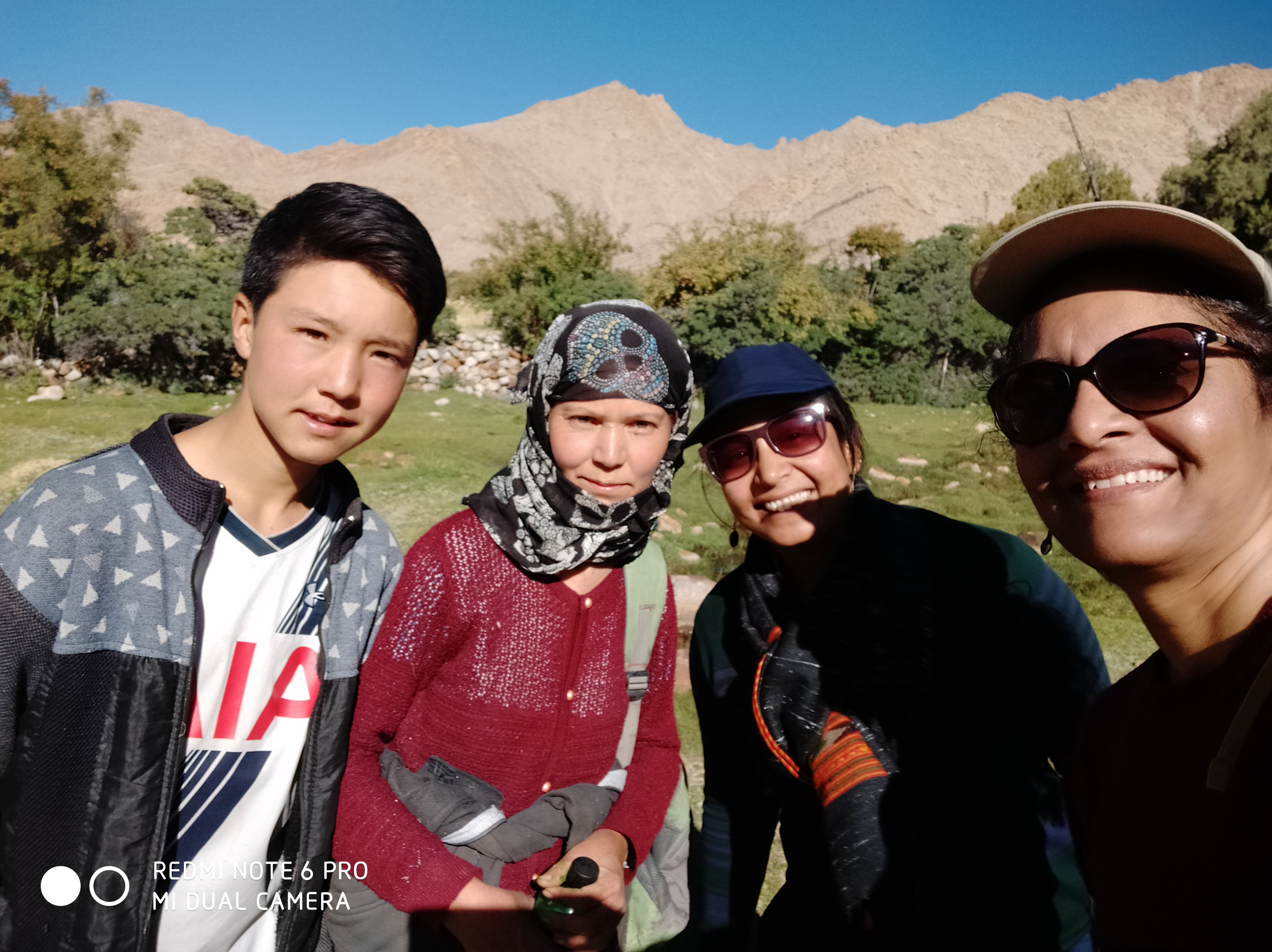 We were amazed. He also introduced us to his mother. They even invited us home for tea.
We were amazed. He also introduced us to his mother. They even invited us home for tea.
After some time walking around the village, we headed back to our homestay. On the way back we noticed that several farm labourers returning after their days work. They told us that they were from Bihar and had come here to work during the harvest season.  Our guides told us that irrigation systems and water management had improved tremendously in Ladakh. A lot of land was under cultivation and most villagers were doing well. This was very heartening to know.
Our guides told us that irrigation systems and water management had improved tremendously in Ladakh. A lot of land was under cultivation and most villagers were doing well. This was very heartening to know.
We were also told that medical facilities in Ladakh were quite good. There was an ambulance for every 5-10 villages and would ply them to the nearest hospital, usually less than an hour away.
It was also good to see that these little villages had Government schools.
The evening in Hemis Shupkachen was spent making the local delicacy momos under the strict supervision of our super efficient homestay owner. That evening we also learnt that our driver Stenzin was among those hired by the Indian Army to work as a porter carrying good to Siachen during winters.
That evening we also learnt that our driver Stenzin was among those hired by the Indian Army to work as a porter carrying good to Siachen during winters.
It suddenly occurred to us that Tenzin was perhaps smiling all the time because he found our struggles on these mountains amusing. He was embarrassed and told us that we were doing a great job. But now we were certainly in awe of our mild mannered driver who was one of the heroes who helped the Indian Army survive in the world’s highest battlefield.
Day 3! We braced ourselves for the toughest day of the trek. We had already covered about 25 kms in 2 days. The first 2 hours of the trek was relatively simple.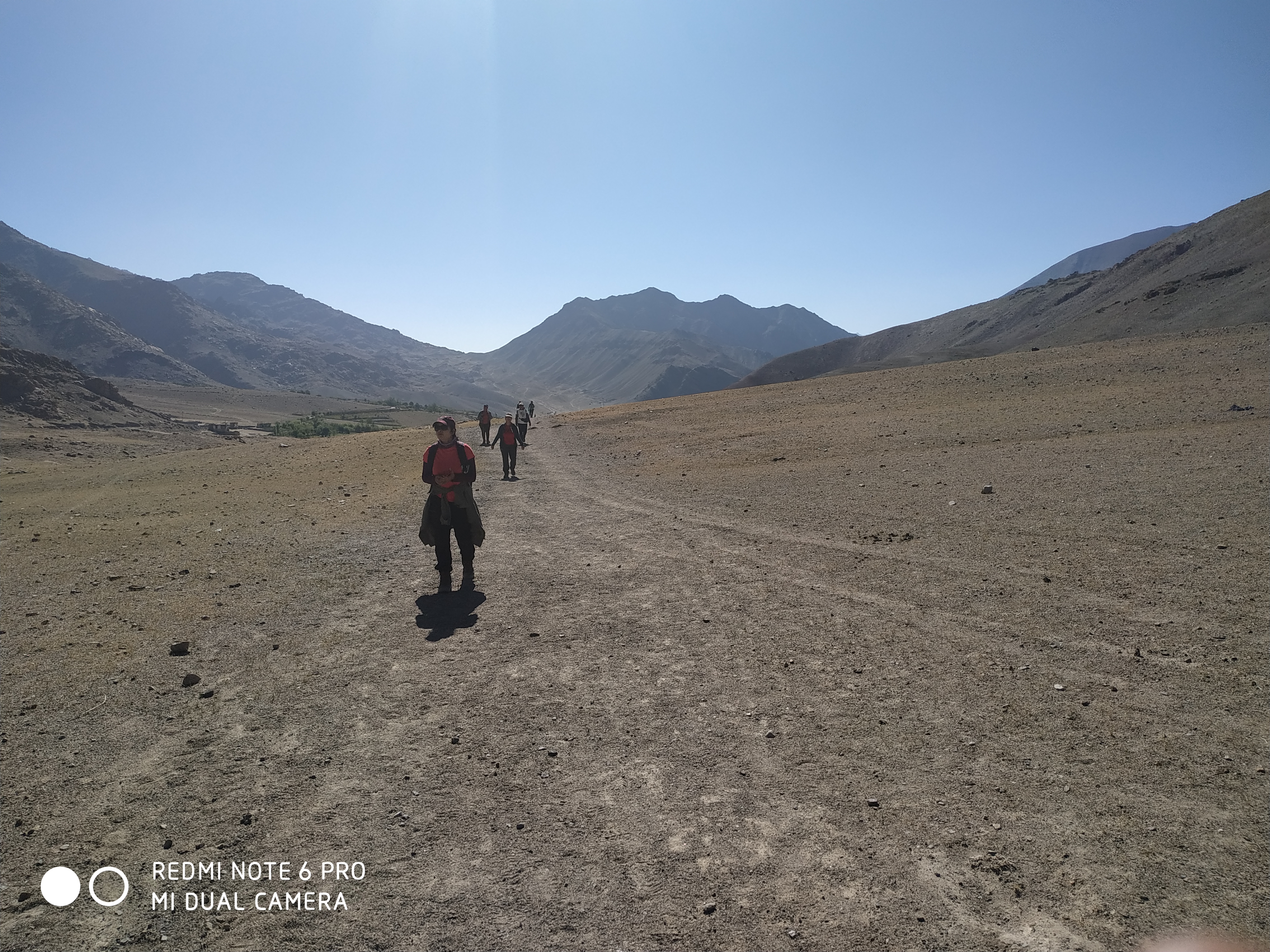
 We reached a small pass and found the vehicle waiting there. 2 members of our group decided to take the road route.
We reached a small pass and found the vehicle waiting there. 2 members of our group decided to take the road route.  The rest of us took the trekking path. We could see the route all along to the top at Mabtek La.
The rest of us took the trekking path. We could see the route all along to the top at Mabtek La.
Sonam turned out to be a wonderful guide. The initial portion of the trek was a steep downhill climb. We moved on to the next mountain. At that point he insisted that the group walk together. It was decided that we would all take 100 steps and then take a break. Next we took 80 steps and rested. 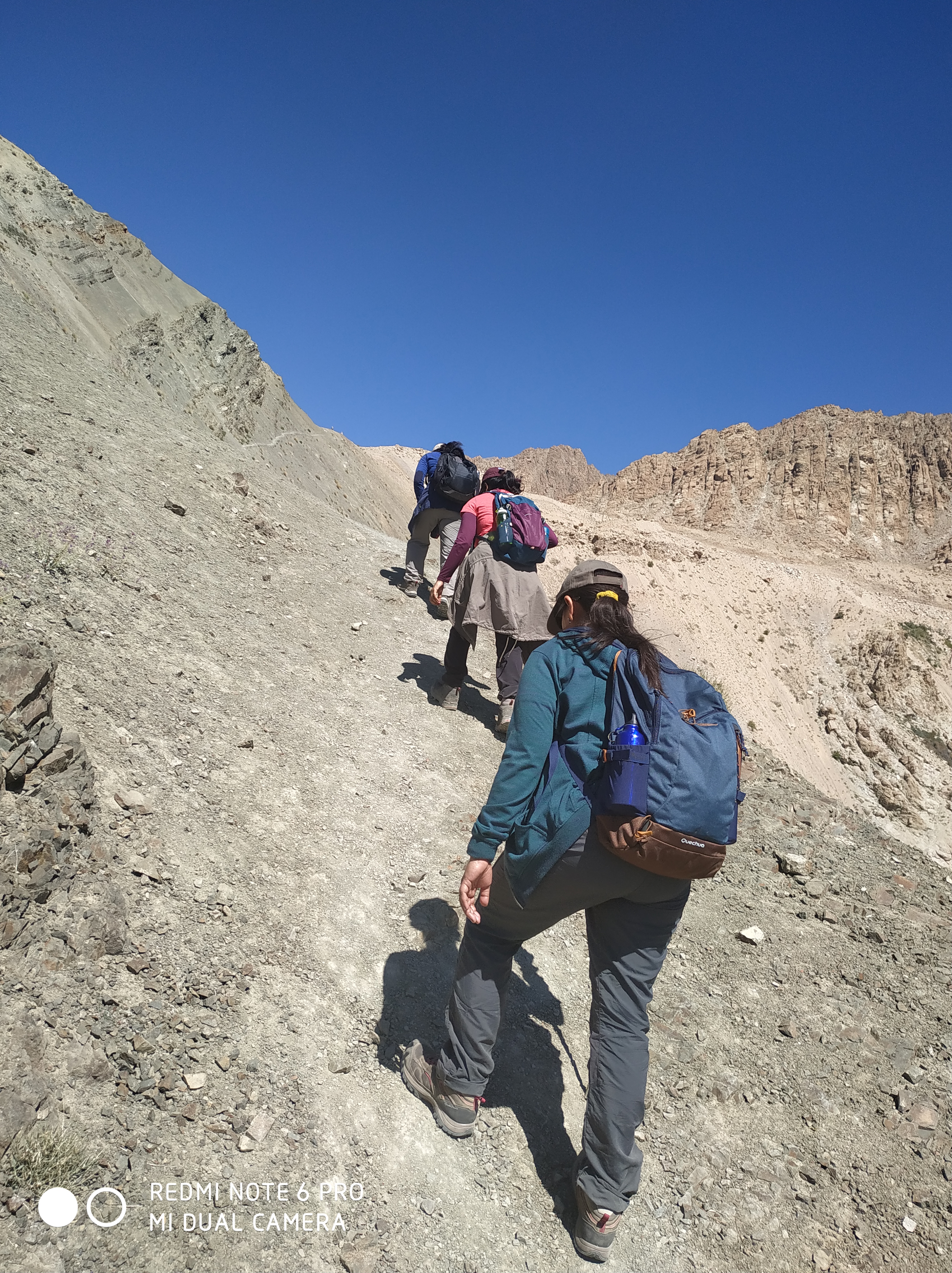

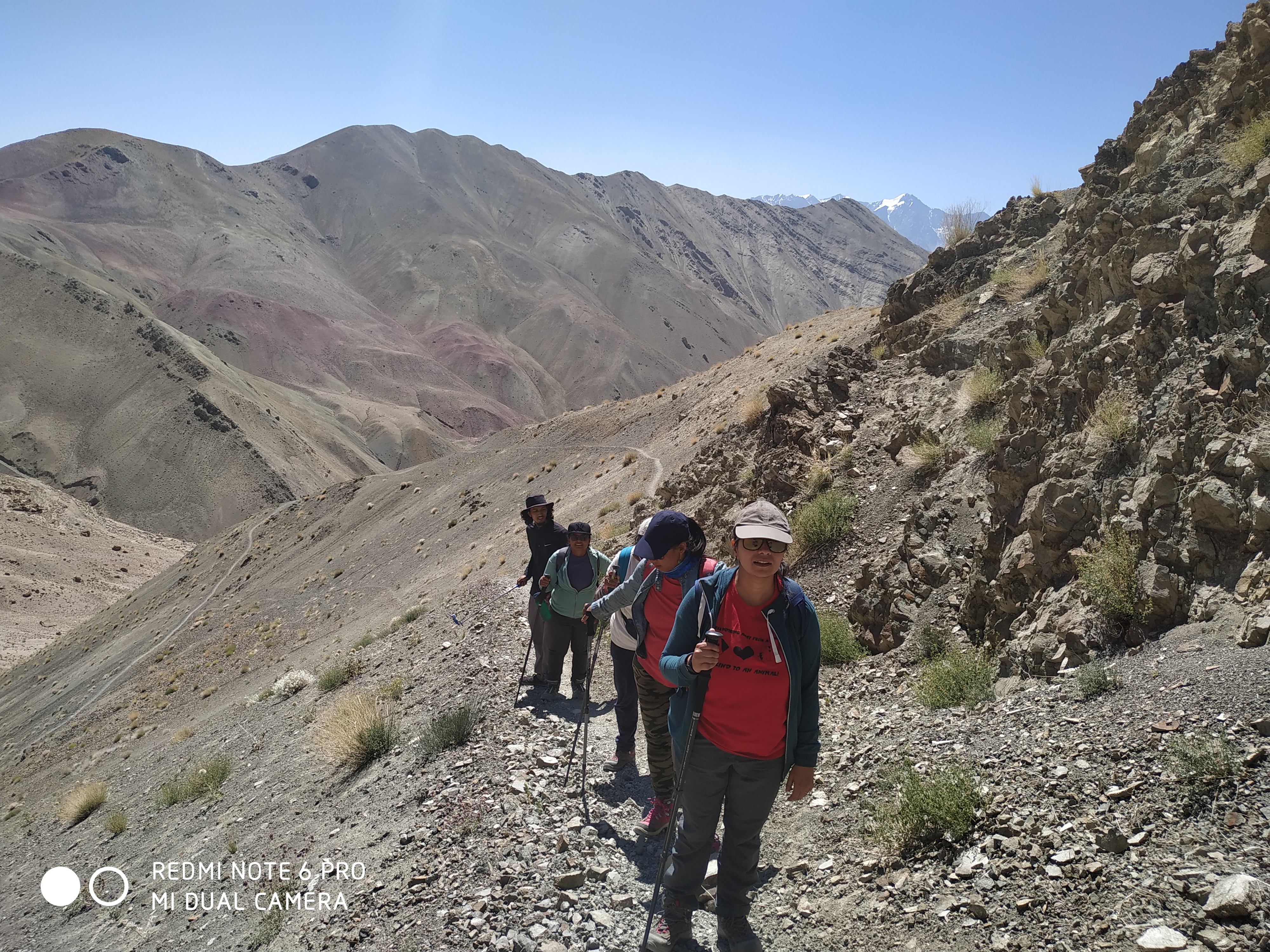 As the terrain got steeper the number of steps reduced. Finally we were resting after every 20 steps. We did this consistently for about 1 hour and reached the top. It was a thrilling moment.
As the terrain got steeper the number of steps reduced. Finally we were resting after every 20 steps. We did this consistently for about 1 hour and reached the top. It was a thrilling moment.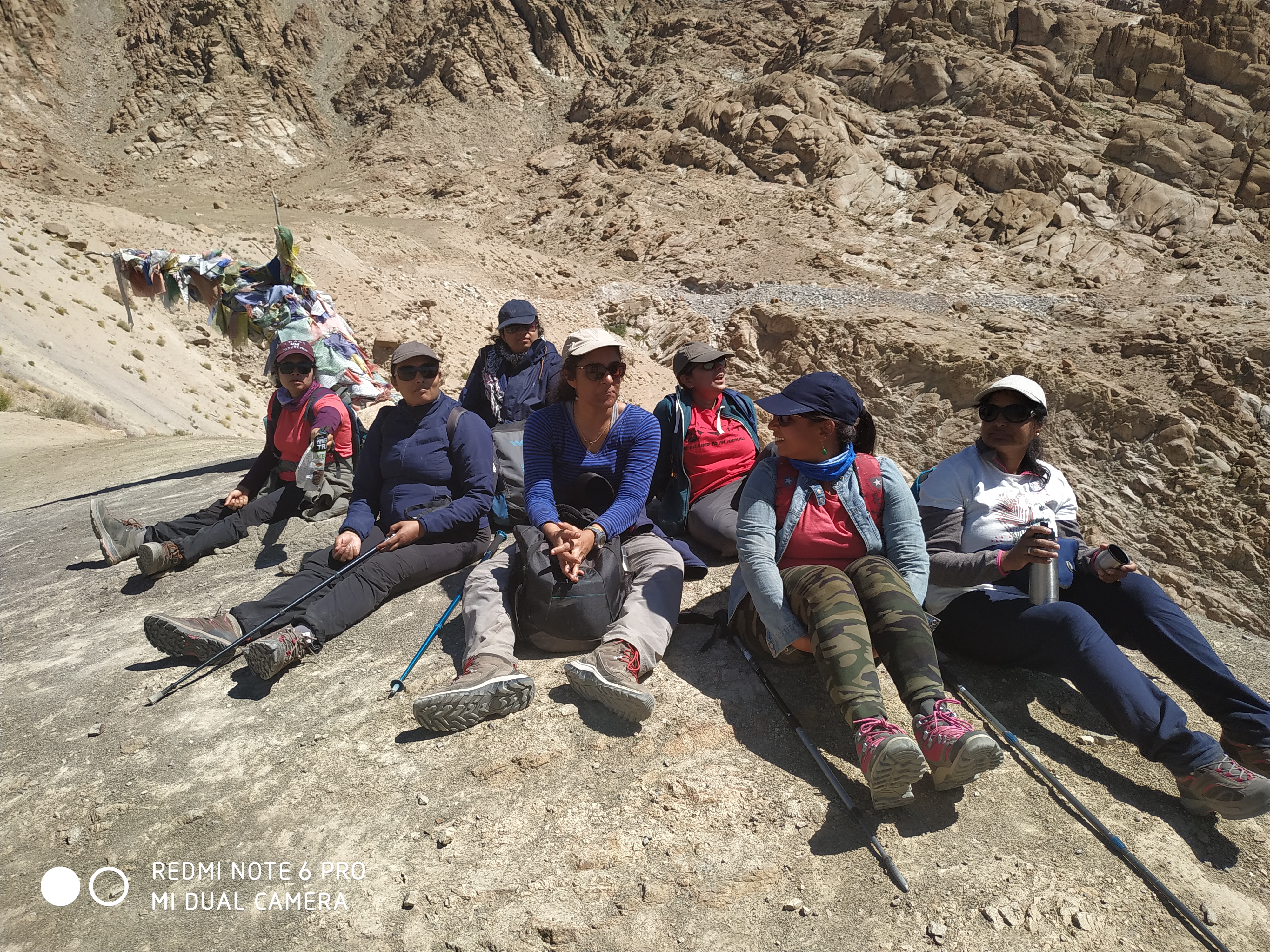 3 of us along with our guides and driver decided to explore some higher regions around Mabtek La. The view was beautiful.
3 of us along with our guides and driver decided to explore some higher regions around Mabtek La. The view was beautiful.  The 3 of us were extremely satisfied and even somewhat sentimental for having decided to do this trek.
The 3 of us were extremely satisfied and even somewhat sentimental for having decided to do this trek. An extensive photo session and then we headed down.
An extensive photo session and then we headed down.
The rest of the group, tired of waiting had decided to trek down to Temisgam village. We also joined them. It was a long trek down. 
 We finally reached Temisgam, a pretty village but not comparable to Hemis Shupkachen.
We finally reached Temisgam, a pretty village but not comparable to Hemis Shupkachen. 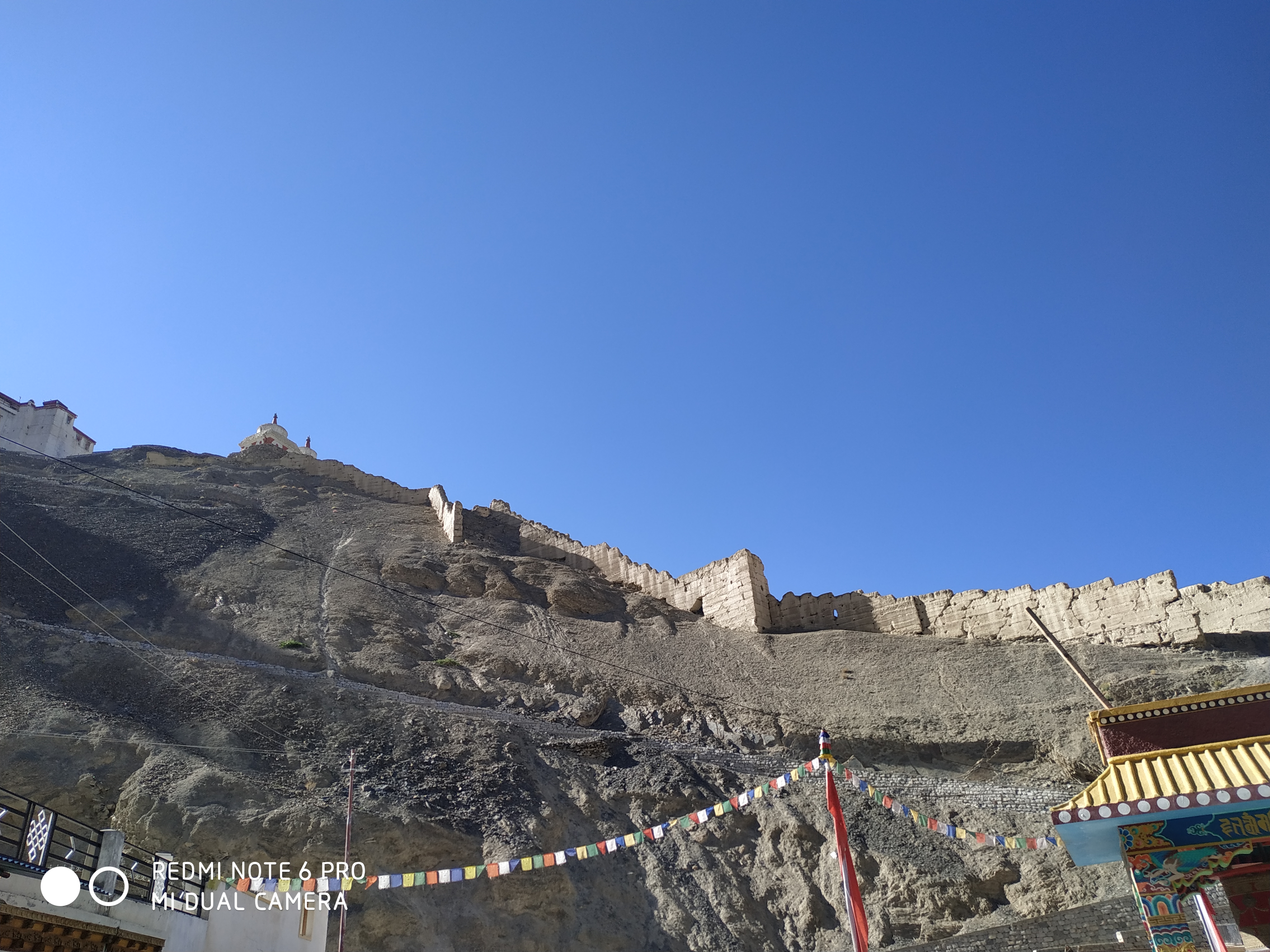
 We stayed in a beautiful modern homestay. The home had several apricot and apple trees. We purchased home grown and processed dry apricots from the family.
We stayed in a beautiful modern homestay. The home had several apricot and apple trees. We purchased home grown and processed dry apricots from the family.
That evening we spent a long time talking and playing games. The family members also joined us. It had been a long, tiring but extremely satisfyingly day.
The last day’s trek was to Khaltse. It was a sunny day and a long walk. We would also cross the last pass of out trek, the Bongnongchan La pass.
Our guide Sonam told us that this would be a regular road trek as the trekking route had now been converted into a proper road. 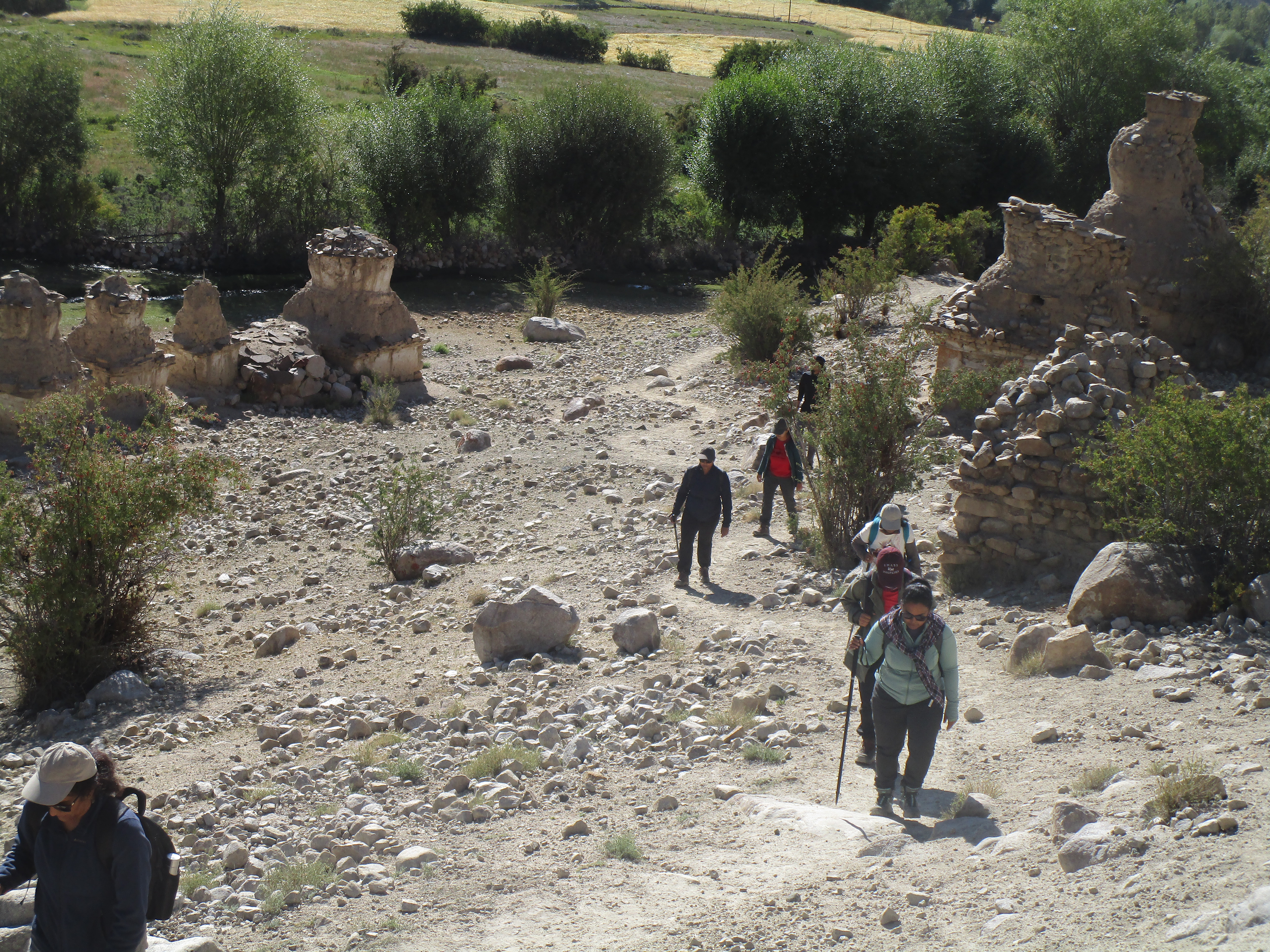 The 21 km stretch we walked on was extremely dusty. Sonam and Urgyan told us that roads were being laid on several trek routes.
The 21 km stretch we walked on was extremely dusty. Sonam and Urgyan told us that roads were being laid on several trek routes. 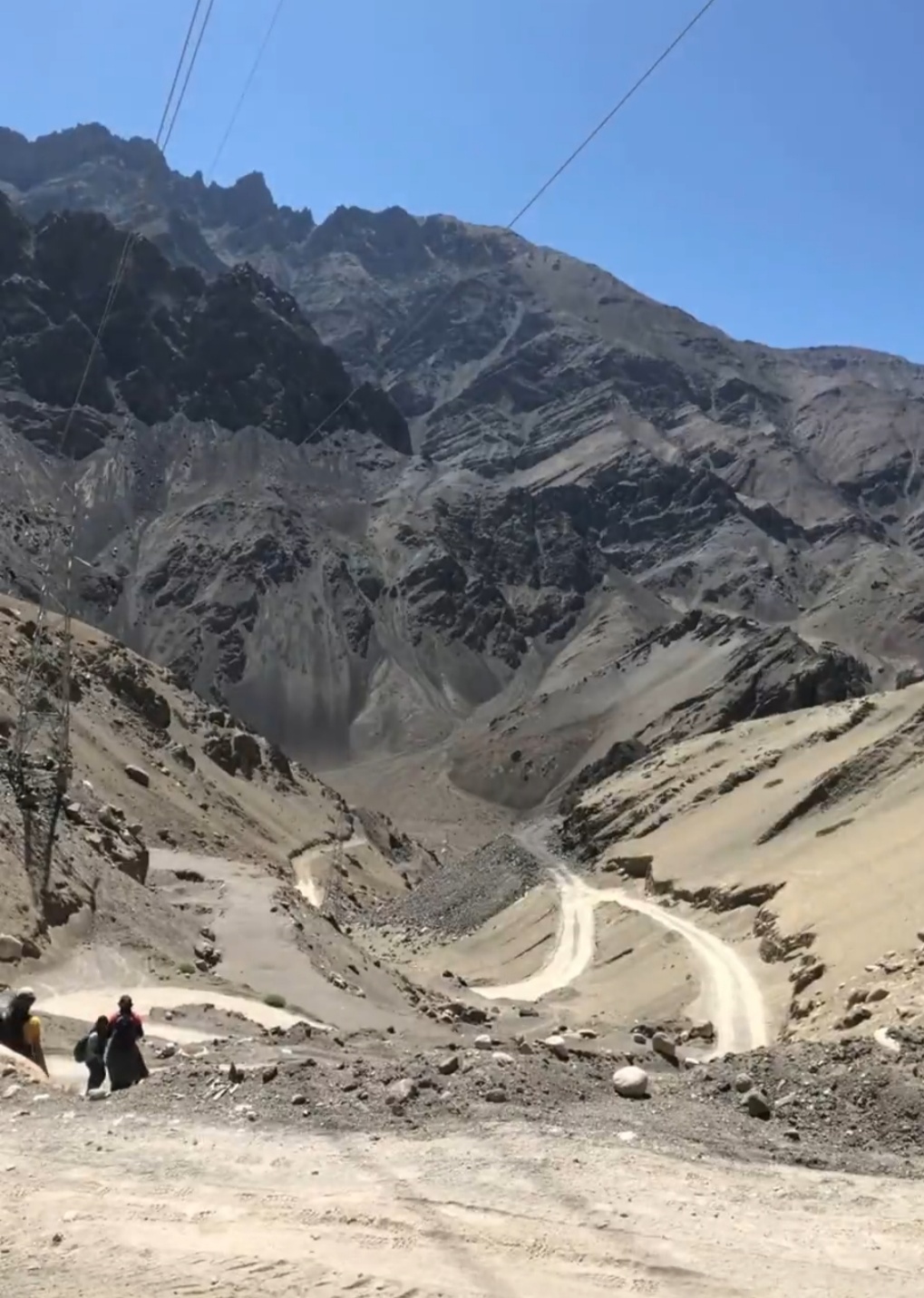 They seemed concerned if development was in some ways ruining Ladakh.
They seemed concerned if development was in some ways ruining Ladakh.
The development debate raged on throughout our trek. We all hoped that the Union Government would focus on sustainable development and ensure that local culture and the environment would stay preserved.
Our guides Urgyan and Sonam were young men in their early 20’s. They were obviously very proud of Ladakh and wanted a future there. But yet they had their fears.
Ladakh’s tourist season lasted just 4 months. They wished they could have a permanent job.
We asked them what they did in winter. They said most people did nothing. Some families moved to warmer places like Jammu or Delhi in the winters.
Sonam told us that his family belonged to a nomadic tribe and were based in a village 150 kms from Leh. Every winter they came down to warmer areas with their livestock.
Interestingly Sonam is involved with a community programme and works with school children during the non-tourist season. He said that they even conducted classes for children in tents.
Both the young men believed that tourism had huge potential. They just hoped that the Government would involve local in all the plans pertaining to the industry.
We finally reached the Sringar-Leh highway along the Indus river. 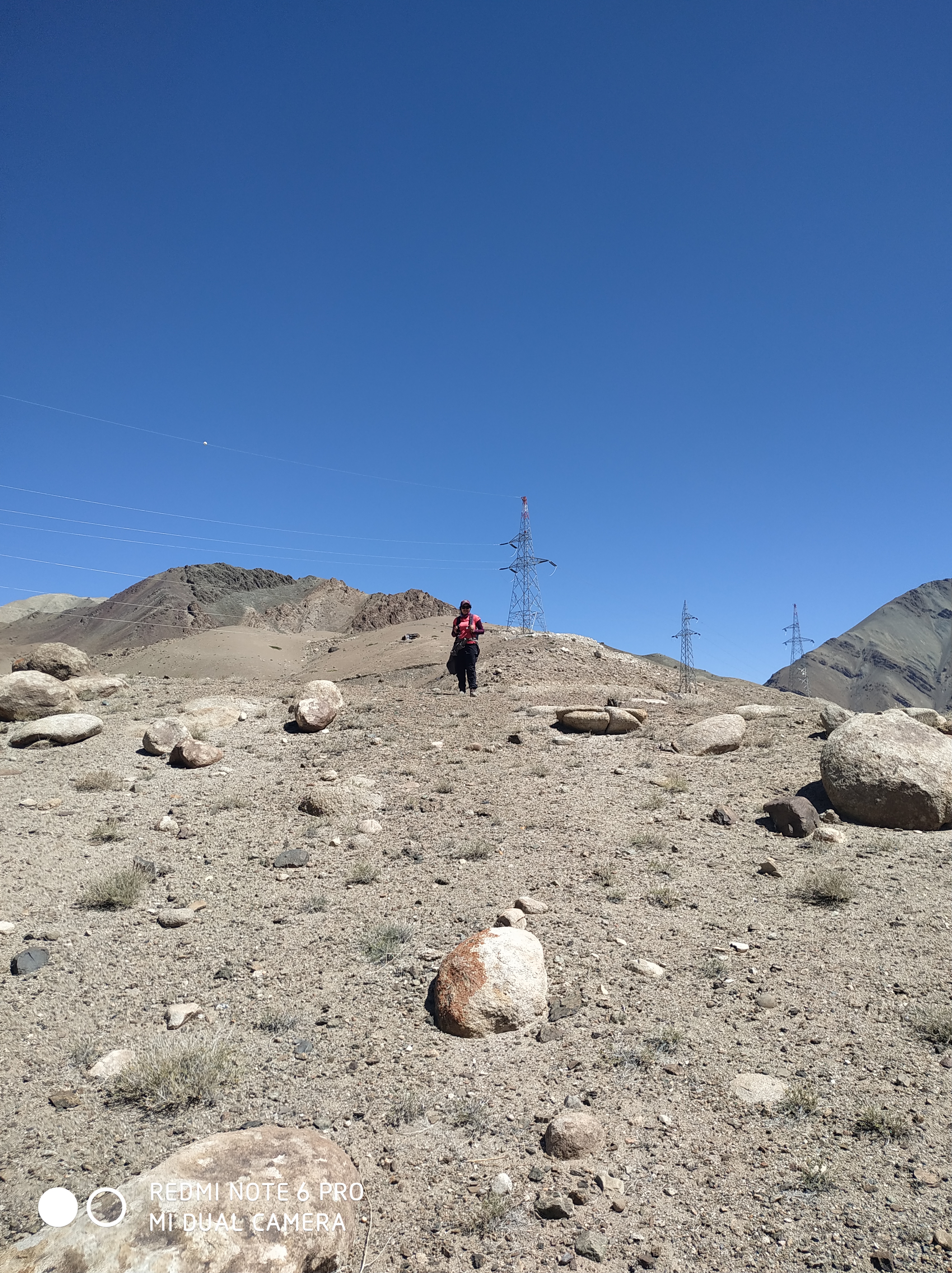 We had completed 60 kms in 4 days.
We had completed 60 kms in 4 days. 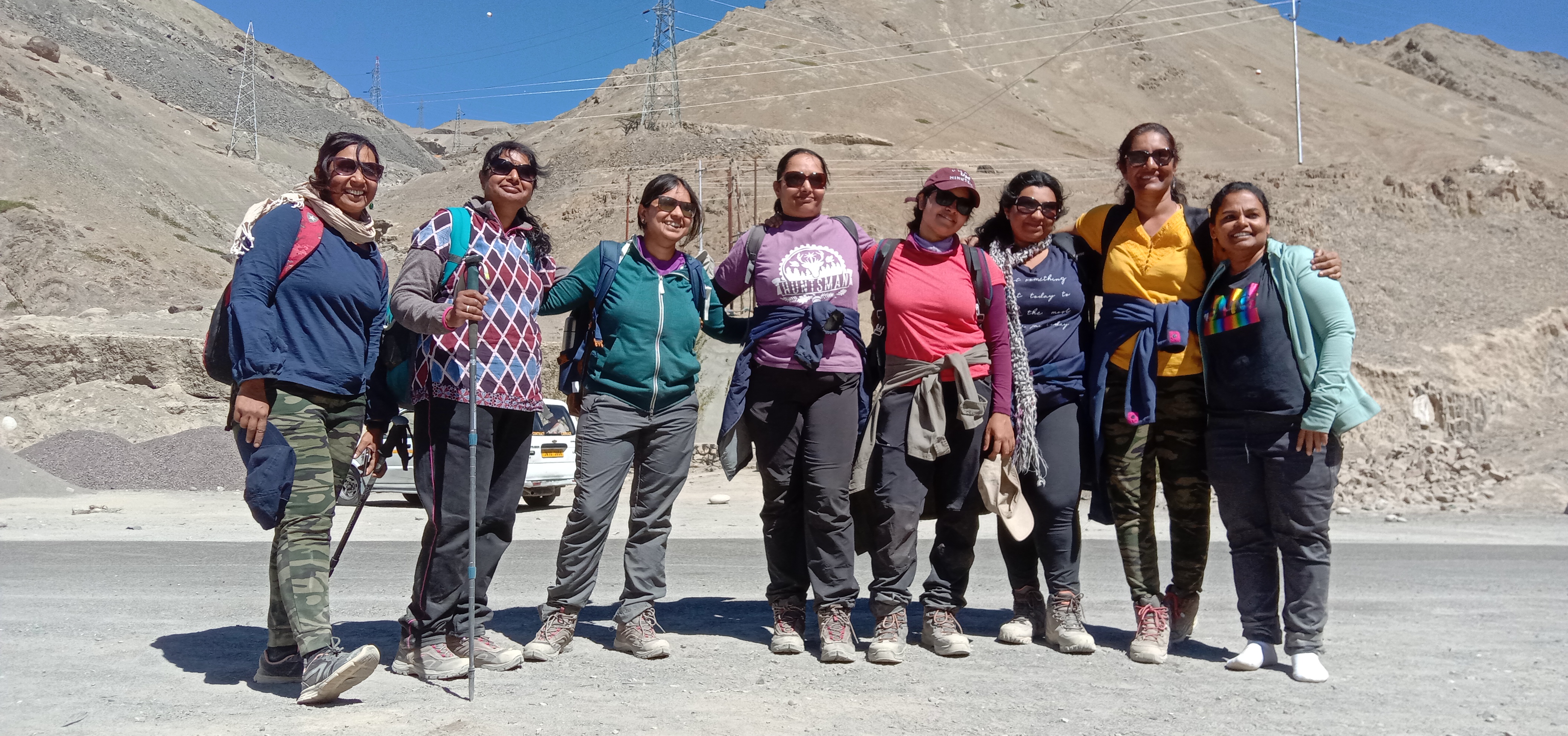 We then drove to the ‘moon land’ Lamayuru.
We then drove to the ‘moon land’ Lamayuru.  The terrain near Lamayuru is believed to resemble the landscape on the moon and hence the name.
The terrain near Lamayuru is believed to resemble the landscape on the moon and hence the name.
We also visited the beautiful Lamayuru monastery  and headed towards Alchi.The road from Lamayuru to Achi was beautiful.
and headed towards Alchi.The road from Lamayuru to Achi was beautiful. Alchi is one if the oldest monasteries in the region. It is believed to have been sanctioned by a Hindu king and built by local Kashmiri artisans (at that time the local Kashmiris were predominantly Hindu).
Alchi is one if the oldest monasteries in the region. It is believed to have been sanctioned by a Hindu king and built by local Kashmiri artisans (at that time the local Kashmiris were predominantly Hindu).  I was taken aback to see the doorway to the main temple at the Alchi monastery. It was near identical to the doorway of my ancestral home in interior Tamil Nadu.
I was taken aback to see the doorway to the main temple at the Alchi monastery. It was near identical to the doorway of my ancestral home in interior Tamil Nadu. 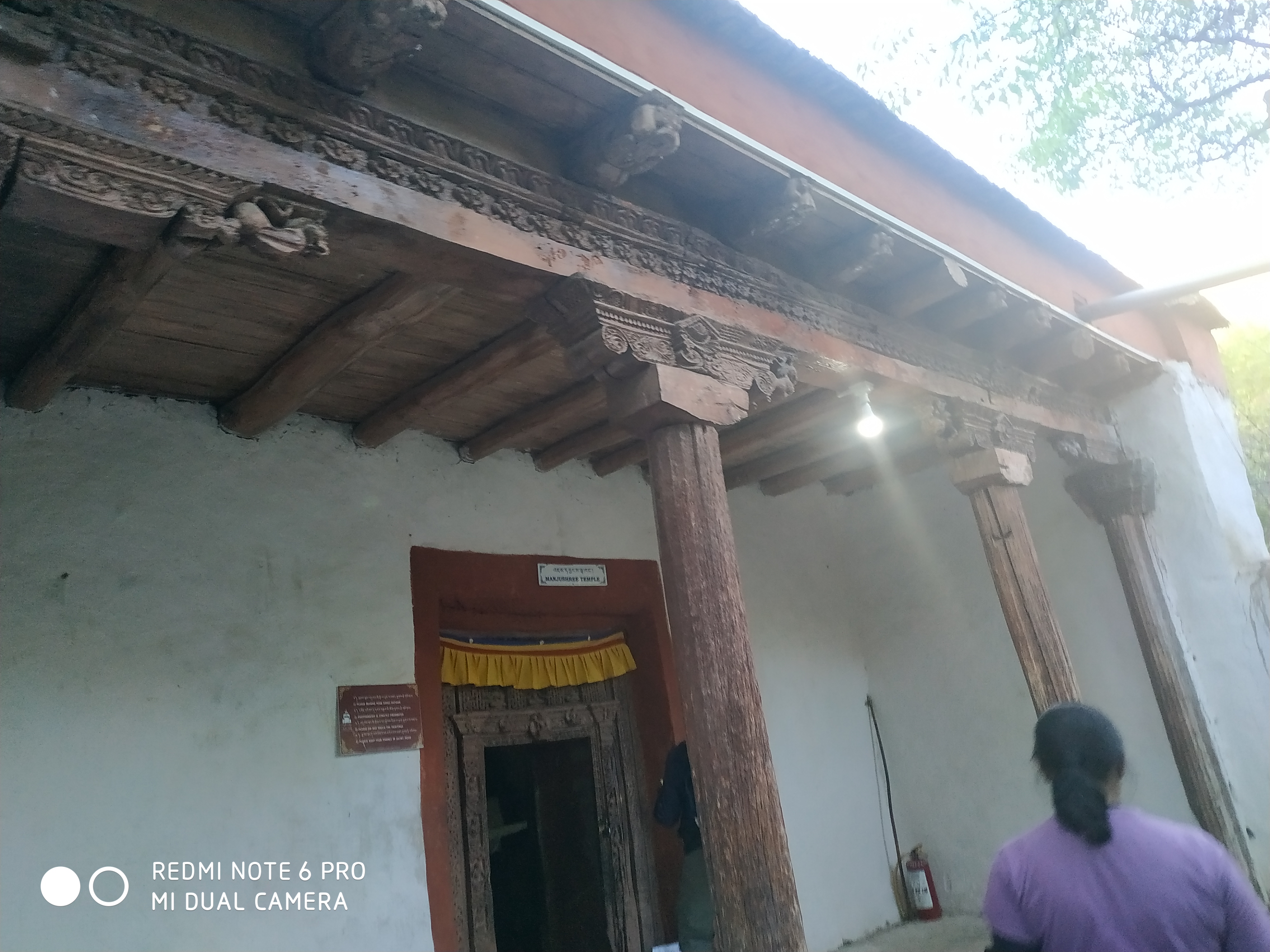
 The ‘Indian’ identity suddenly made sense. For thousands of years Indians have travelled, shared knowledge and skills to create what we recognize as Indianness.
The ‘Indian’ identity suddenly made sense. For thousands of years Indians have travelled, shared knowledge and skills to create what we recognize as Indianness.
The Indus river flowed right behind the monastery.  We spent the night at Leh .The next morning we had a relaxed breakfast and went to see the ‘Sindu Sangam’, the point where the river Indus meets the river Zanskar.
We spent the night at Leh .The next morning we had a relaxed breakfast and went to see the ‘Sindu Sangam’, the point where the river Indus meets the river Zanskar.
We wanted to take a dip at the sangam, but were taken aback when Urgyan spontaneous response to that was ‘marna hai kya?’ Tenzin our tour organiser also told us that the water was likely to be very cold. He said that the glacier that feed the zanskar river was just 80kms away and hence the water would be extremely cold.  Good sense prevailed and we gave up the idea. The sangam is a beautiful place. We spent over an hour there just looking at the waters.
Good sense prevailed and we gave up the idea. The sangam is a beautiful place. We spent over an hour there just looking at the waters.
We then stopped at the Nimoo market to savour the famous samosas at Puran Hotel.  We were told that 2500-3000 samosas were sold every day at this tiny joint.
We were told that 2500-3000 samosas were sold every day at this tiny joint.
We also visited the Bagso palace  and headed to the Leh market.
and headed to the Leh market.
We placed an order for customised tshirts. After lunch at the German bakery we split into smaller groups and exored the marketplace.
2 of us went to the old part of leh city also called LAMO.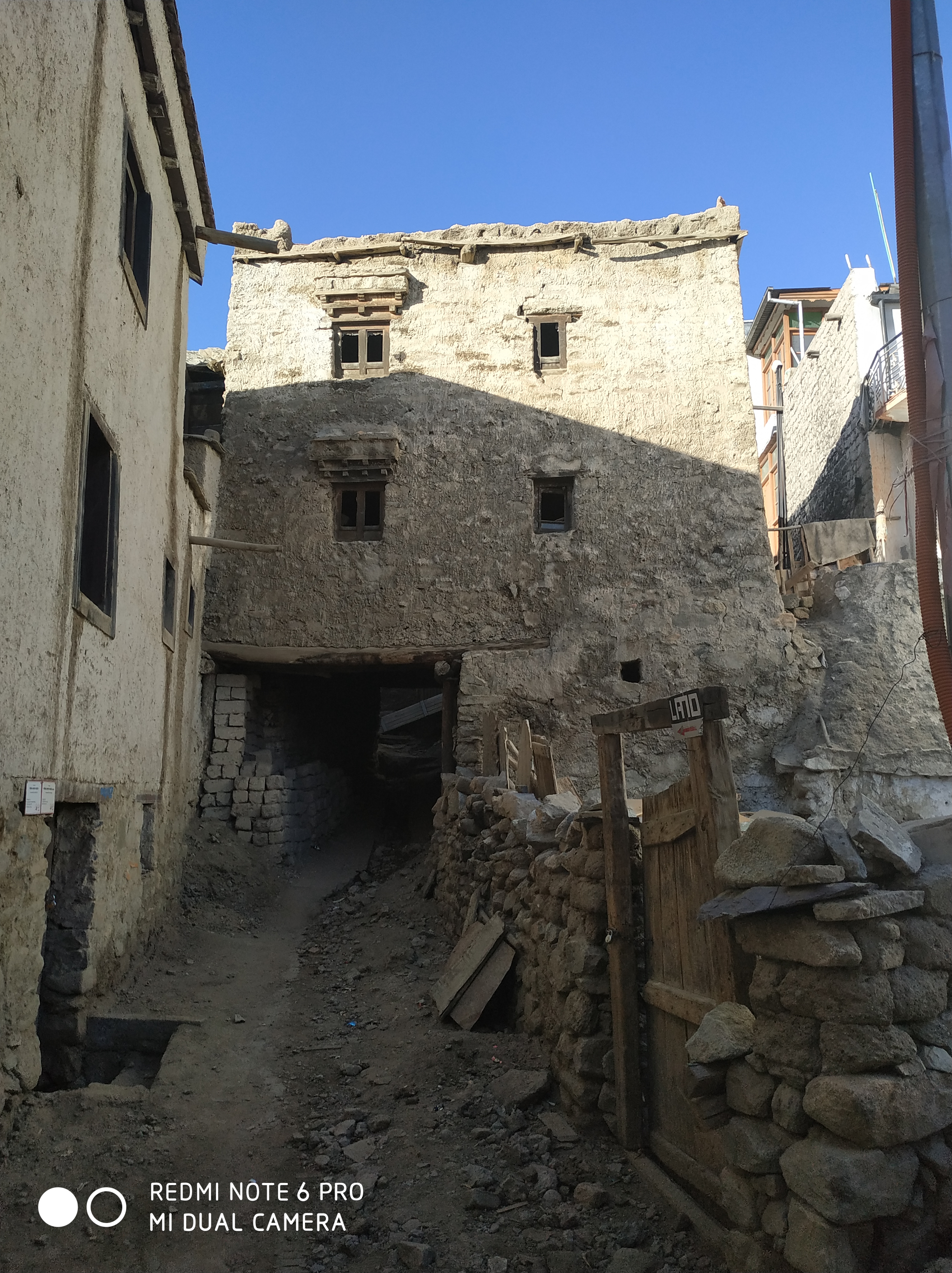
 We stopped by a quaint restaurant to have apricot juice.
We stopped by a quaint restaurant to have apricot juice.
We then picked up some Tanka paintings and headed back to our rooms.
That evening Tensing had a small felicitation for our group as we were guests to Ladakh.  We also chatted with him for a while. A Tibetan by birth, he told us that Tibet was of great statregic importance and the glaciers that fed some of the biggest rivers were located there. It was an interesting conversation and like the rest of the trip a learning for us.
We also chatted with him for a while. A Tibetan by birth, he told us that Tibet was of great statregic importance and the glaciers that fed some of the biggest rivers were located there. It was an interesting conversation and like the rest of the trip a learning for us.
The next morning we took the flight back to Delhi.This time we landed on time. The transfer from Terminal 1 to Terminal 2 took us 40 minutes.
Delhi, we felt, wanted to keep us in a state of excitement. Following an exhausting check in and security check process we were ready to head back home.  A wonderful trek and an experience that has given us many beautiful memories.
A wonderful trek and an experience that has given us many beautiful memories.